
The Navy Department Library
LOG OF THE TRIP OF THE PRESIDENT TO THE CASABLANCA CONFERENCE
9-31 JANUARY, 1943
PDF Version [9.4MB]
FORWARD
In December 1942, the Commander-in-Chief, Franklin D. Roosevelt, decided to rendezvous with the Prime Minister of Great Britain, Winston Churchill, at a suitable place in North Africa. Thus would the President and the Prime Minister be afforded an opportunity to confer, and, with their military and naval staffs, inspect the United Nations forces, which had landed successfully in North Africa the previous November.
Plans for transporting the President and his party by land and air were drawn up. Advance parties comprising Secret Service agents, as well military and naval advisors, left early in January 1943. In this manner arrangements were perfected along the route which the President was to follow through North America and South American to the continent of Africa.
Saturday 9 January
In the national capitol not even the White House staff was aware that this mission would be the most unprecedented of Presidential trips. In a time of war, the Chief Executive was to leave the United States, fly the Atlantic and rendezvous with the British Prime Minister close to the theatre of actual hostilities in North Africa.
It was shortly before ten o’clock in the evening when the President and his party secretly left the White House.
The special train, which was to carry the party to Miami, had been prepared and awaited the President’s arrival. Mr. Dewey Long had arranged this detail. Baggage, food and other supplies had been stowed aboard one hour before scheduled departure. The crew was especially selected. With the exception of the engineer and fireman (who could hardly be expected to determine the identities of the persons aboard), all regular employees of the railroad company of the Pullman company had been purposely informed that their services would not be required for this trip. Two officials of the railroad and Pullman companies had instructed five Filipino messmen from the USS Potomac, the President’s ship, throughout the day in the technique of making up berths and operating other equipment on the train. The appetites and other wants of some thirty people had to be taken care of by these five messmen. Food for the party was to be supplied through the commissary section of the President’s private car. Tray service was provided for all who were not actually messing with the President in his private car. Due to the small number in the party, it was unnecessary to make up a large train. Exclusive of the President’s
-1-
own car, the train comprised one compartment car, one Pullman sleeper, one combination club-baggage car, and the special Army radio car.
Sunday 10 January
The train rolled smoothly southward during the night. The following morning it became quickly evident that five messmen were insufficient to care for the messing and berthing needs of the Presidential party. Accordingly, a letter was sent to Lieutenant Kevers asking that three additional mess attendants arrive at the Naval Air Station, Jacksonville, awaiting the President’s return to the United States.
Despite the disadvantage of being too few in number, the five Potomac messboys outdid themselves. Tray breakfasts of scrambled eggs, bacon, toast, jam, and coffee had all hands in fine fettle. A substantial luncheon of chicken chow mein, boiled rice, peas, bread, butter, and iced tea was served, and the evening meal consisted of broiled steak, French fried potatoes, asparagus, and baking powder biscuits, topped off with strawberries and cream, and coffee. All hands agreed that the regular dining car could be dispensed with so long as Navy messmen could do so well with the compact cooking facilities recently installed in the President’s newly-designed traveling car. Food at cost, i.e., 50 cents per meal, also proved to be a popular feature of the arrangements.
A set of scales was picked up at Savannah, and during the afternoon, Messrs. Spaman, Long, Terry, Haman, and Black carefully weighed and tagged all the baggage, for it was felt that accurate information was
-2-
essential as to the weight carried in the two planes in which the party was scheduled to take off from Miami. The afternoon’s calculations indicated that there were approximately 3100 pounds of personnel, 2200 pounds of luggage, and 900 pounds of bottled table water. Red baggage tags were placed on material, which was to be stowed in Plane #1, while green tags were affixed to material which was to be stowed in Plane #2. The ten cases of water were to be distributed evenly, five in each plane.
Monday 11 January
The Presidential train arrived at Military Junction, Miami, at 1:30 in the morning. Baggage and water for both planes, and all personnel for Plane #2, were unloaded into Army trucks and cars and despatched[sic] to the Pan-American Airways base. The train remained at Military Junction until shortly after five o’clock; then it proceeded to Miami. The President and those who were to travel in Plane #1 detrained at 5:45 A.M. at 27th Avenue and Dixie Highway. They left immediately by automobile for the Pan-American base.
The two planes which were to carry the party from Miami to Trinidad were Boeing Clippers, owned and operated by Pan-American, but under charter to the Navy. Powered by four Wright 1550 horsepower engines, each plane has a gross weight of forty-four tons when fully loaded with passengers and fuel. Planes of this type have a long-range cruising speed of 130 knots, and carry a standard crew of eleven, with duties as follows:
Captain
1st Officer
2nd Officer (usually the Navigator)
3rd Officer
4th Officer
3
Flight Engineer
Assistant Flight Engineer
Flight Radio Officer
Steward
Assistant Steward
When fueled to capacity, these planes have a cruising range of 3800 miles at economical cruising speed. However, when carrying maximum pay load the cruising range decreases to 2100 nautical miles. Each plane is equipped to carry about 4600 gallons of gasoline, weighing about 14 tons.
The President and his party embarked as follows:
Plane #1 – The President
Mr. Hopkins
Admiral Leahy
Rear Admiral McIntire
Captain McCrea
Messrs. Spaman, Fredericks and Hipsley (S.S. Agents)
Arthur Prettyman (Valet)
Plane #2 – Colonel Beasley, Signal Corps
Captain George Durno, A.T.C.
Lieutenant George Fox, U.S.N.
Chief Ship’s Clerk Terry, U.S.N.
Messrs. Beary and Marshall (S.S. Agents)
Chief Photographer’s Mate Black, U.S.N.
1st Sergeant Hoch, U.S.M.C.
Plane #1, carrying the President and piloted by Captain Cone (Lieutenant U.S.N.R.) left the dock and proceeded to the take-off area, where it soared into the sky shortly after 6:00 A.M. bound for Trinidad, 1410 miles to the southeast.
Plane #2 took off at 6:34 A.M. and was in the air 30 seconds later, Captain Vinal (Lieutenant U.S.N.R.) at the controls. Plane #2 followed about 35 miles to the rear of the President’s Plane.
Shortly after taking off, course was set at 1350, and after gaining altitude for 40 minutes, the flight leveled off at 9000 feet.
-4-
Sunrise was observed at 7:50, and at 8:00 A.M. course was altered to 1240. At 9:35 A.M. course was again altered to 1290, and at 9:38 the southwest point of Great Inagua Island was sighted. At 10:45 Haiti was observed. Passage had been completed over the eastern portion of the Island of Hispaniola, upon which Haiti is situated, at 11:14.
Plane #1 while over Haiti, circled Christophe’s Citadel to afford the President an aerial view of this historical fortress which he had visited in 1917 when serving as Assistant Secretary of the Navy.
At 12:25 course was altered to 1320 and at 12:45 there occurred a minor weather front which was not as turbulent as first expected. At 1:20 P.M. course was changed to 1360 and at 2:09 P.M. a celestial fix of the sun and moon was obtained. The planes started their descent at 3:45 P.M. and at 4:10 P.M. Trinidad was sighted. La Boca Grande (the “Big Mouth” of the Gulf of Paria) was entered at 4:15, and at 4:24 the President’s plane landed in the waters off the newly-constructed Naval Air Station, Trinidad.
The weather on the way down from Miami was generally most favorable, as only light scattered clouds and no air disturbance was encountered.
The President thoroughly enjoyed the first leg of his scheduled 6000 mile flight to his rendezvous with Prime Minister Churchill in North Africa.
Fourteen hundred and ten nautical miles and been traveled from the dock at Miami to the dock at Trinidad. In slightly over ten hours the flight had maintained an average air speed of 146 miles per hour. One hour and 44 minutes and been flown in darkness.
-5-
Upon landing at Trinidad, the President and his party left in launches for the dock at the Naval Operating Base, and upon disembarking transferred to automobile for a delightful 15-minute drive to the Navy operated hotel at Macqueripe.
It was quite evident that every arrangement had been made for the comfort of the President and his party. The Secret Service advance party and local Naval officials did their work well. The patio of the hotel afforded a delightful view of the bay, and this, coupled with a mild sea breeze, made it possible for the President to relax a bit before dinner.
Over a cocktail the President chatted with Rear Admiral J.B. Oldendorf, U.S.N., Commandant NOB Trinidad Sector, Caribbean Sea Frontier, and Major General Henry C. Pratt, U.S.A., Commanding General, Trinidad Base Command, these two officers having met the President at the boat landing, joining the party for the drive to the hotel at Macqueripe. Rear Admiral Oldendorf and Major General Pratt were guests of the President this evening at dinner served on the second-floor veranda, just outside the President’s suite. Admiral Leahy, Rear Admiral McIntire, Captain McCrea, and Mr. Hopkins also were guests of the President at this dinner.
It was desired that Plane #2 take off for Belem, Brazil, at 4:30 the following morning. Her passengers, together with their baggage, left the hospitable surroundings of Macqueripe at 11:30 P.M., having decided to spend the night on board the plane. As the President’s plane was not scheduled to take off until 6:00 A.M., its complement remained overnight at Macqueripe and early the next morning embarked in the Clipper which was to take the President on the second half of his flight southward.
For a number of days Admiral Leahy had been indisposed with a
-6-
“hard” chest cold, and the trip so far had not improved his condition. On the advice of Admiral McIntire, the President regretfully decided it would be best for Admiral Leahy to remain behind at Macqueripe.
Tuesday 12 January
Plane #2 did not take off as early as planned, but did leave for Belem at 5:17, preceding the President’s Plane #1 by about 45 minutes. Sunrise was observed at 6:25 and some time after eight o’clock both planes leveled off at 9000 feet.
After having been in the air for seven hours, the flight crossed the equator about an hour before the scheduled time of arrival at Belem. With the exception of the plane crew, Durno, Fox, and Terry were the only shellbacks on board Plane #2, and Neptune party was quickly organized. With Captain Durno sitting on the throne attired as Neptune, with Lieutenant Fox at his left as Royal Adviser, and Chief Ship’s Clerk Terry at Neptune’s right as Royal Prosecutor, the following listed pollywogs were duly initiated and converted into shellbacks:
Pollywog Beasley
“ Beary
“ Marshall
“ Black
“ Hoch
Following the “Crossing the Line” ceremonies and upon our arrival at Belem, a report was handed to the Commander-in-Chief of the Army and Navy, as follows:
“TO THE CHIEF OF ALL SHELLBACKS:
It is reported that all pollywogs infesting Plane #2 were brought to trial this date and
-7-
initiated into the Ancient Order of the Deep, with appropriate ceremony.
Geo. Durno, Capt., A.T.C.
Geo. A. Fox, Lt., U.S.N.
F.J. Terry, C.S.C., U.S.N.”
Plane #2 landed in the River Para at Belem, Brazil, at 2:40 P.M. Plane #1, bearing the President, arrived at 3:30, after having flown 1075 miles since the President had left Macqueripe Beach Hotel at Trinidad that morning.
The President went ashore at Belem and was met by Vice Admiral Jonas Ingram, U.S.N., Commander South Atlantic Force, together with Brigadier General Robert L. Walsh, Commanding General South Atlantic Wing, A.T.C., and Commanding General, U.S. Armed Forces in the South Atlantic.
While our planes were taking on a maximum load of gasoline preparatory to flying, the Atlantic the President and his party, including Admiral Ingram and General Walsh, drove to the nearby Pan-American flying field, now under the control of the Army as part of the Air Transport Command, and were entertained by Major L.E. Arnold, the Commanding Officer of the South Atlantic Wing Station, A.T.C., at Belem, at his quarters.
Shortly after 6:00 P.M. the President and his party returned to the dock at Belem and following a short boat trip, embarked in the two clippers which were now ready to depart for Bathurst, Gambia, 2100 miles to the northeast, on the continent of Africa. The planes took off just before 7:00 P.M. and cruised at only a thousand feet for several hours while fuel consumption diminished the heavy weight of the 4600 gallons of gasoline which had been loaded into each plane at Belem. The
-8-
factor of weight in such a flight is easier to understand when it is noted that each of the planes burned approximately three-fifths of a ton of gasoline during each of the 19 hours it took to make the crossing.
Wednesday 13 January
During the night the flight had “gone upstairs” to 7000 feet but had found it rather turbulent at that level. The President’s plane managed to find comparatively smooth flying weather at 4000 feel and his pilot flew at that altitude for the remainder of the run to Bathurst.
Both planes made perfect landings shortly after 4:30 in the afternoon and were met by motor whaleboats from the USS Memphis, a light cruiser of the South Atlantic Force, normally operating out of Natal. The Memphis had been ordered to Bathurst to provide safe and healthful quarters for the President before taking off for Casablanca the following morning.
Captain H.Y. McCown, U.S. Navy, Commanding Officer, USS Memphis, was on hand to greet the President and reported that automobiles were standing by ashore in case the President might desire to tour Bathurst and the vicinity which had been part of the original plans. Captain McCown informed the President that little of interest was to be seen at Bathurst which could not be observed on the way to the airport the following morning. He suggested that if the President desired to make a tour of the Waterford by boat, the British Naval Officer in Charge,
-9-
Commander E. F. Lawder, R.N., was well informed as to points of interest and could be reached without delay. The President determined on the boat trip in preference to one by automobile. Commander Lawder was accordingly embarked in the President’s whaleboat, and the Commander-in-Chief was accompanied by Mr. Hopkins, Admiral McIntire, Captain McCrea and Captain McCown.
During this half-hour inspection trip many points of interest were observed along the waterfront. Several craft, including a net tender, oil tankers, and barges passed close aboard. It was observed that many of the men working about the decks of these vessels paid little or no attention to the passing whaleboats from the Memphis. How different would have been their attitude had they had the slightest knowledge as to the identity of their distinguished visitor!
The President went on bard the Memphis shortly before six o’ clock. Normally the Memphis carries the flag of Vice Admiral Jonas H. Ingram, Commander South Atlantic Force. Captain McCown, joined the President in the Admiral’s quarters together with Mr. Hopkins, Admiral McIntre, and Captain McCrea for dinner in the President’s Mess.
After dinner the President wrote a number of letters and retired about 11:15 P.M.
The Ship’s Boatswain mentioned to Chief Ship’s Clerk Terry at mess that evening that he could not help but note that on the 13th day of the month, the Commander-in-Chief had come on board light cruiser #13.
-10-
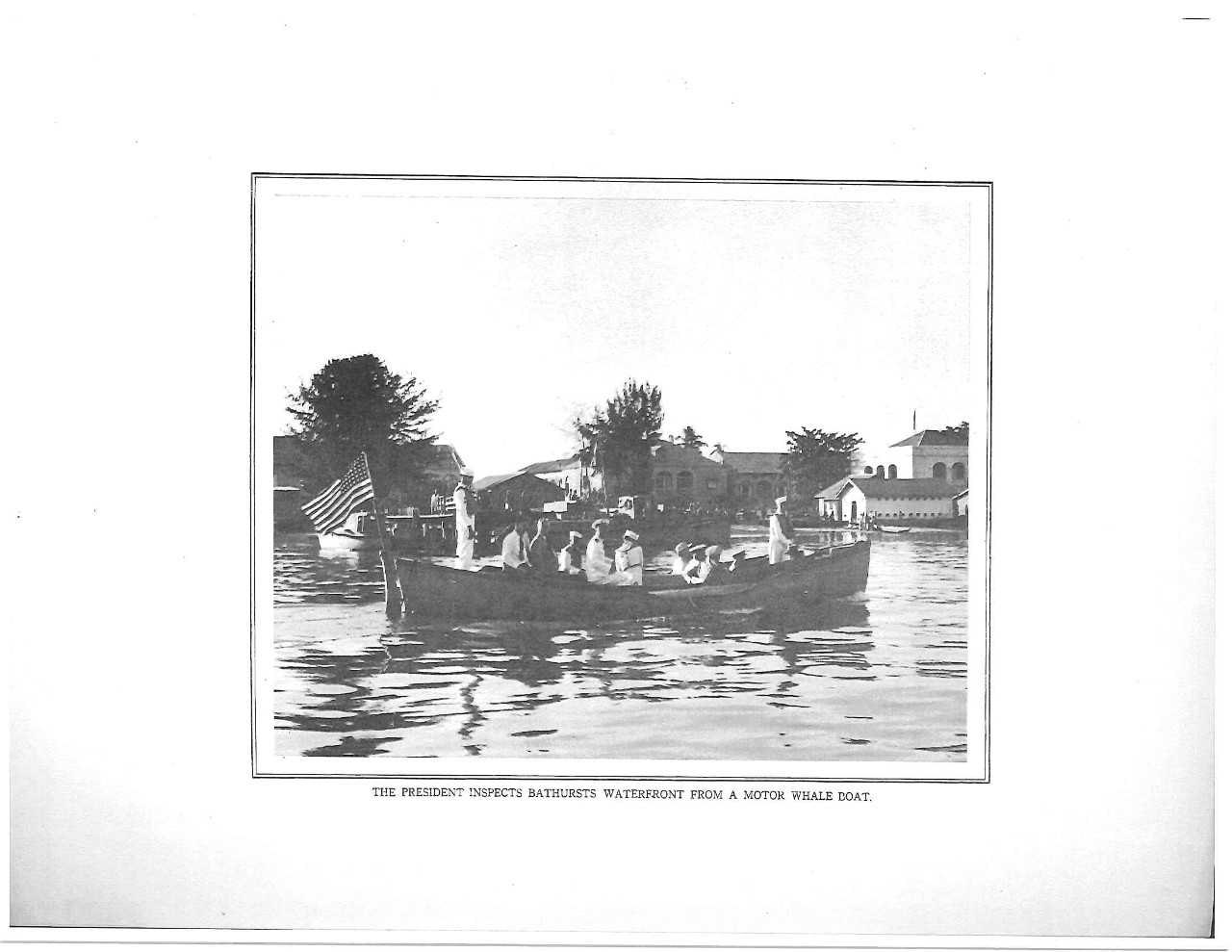
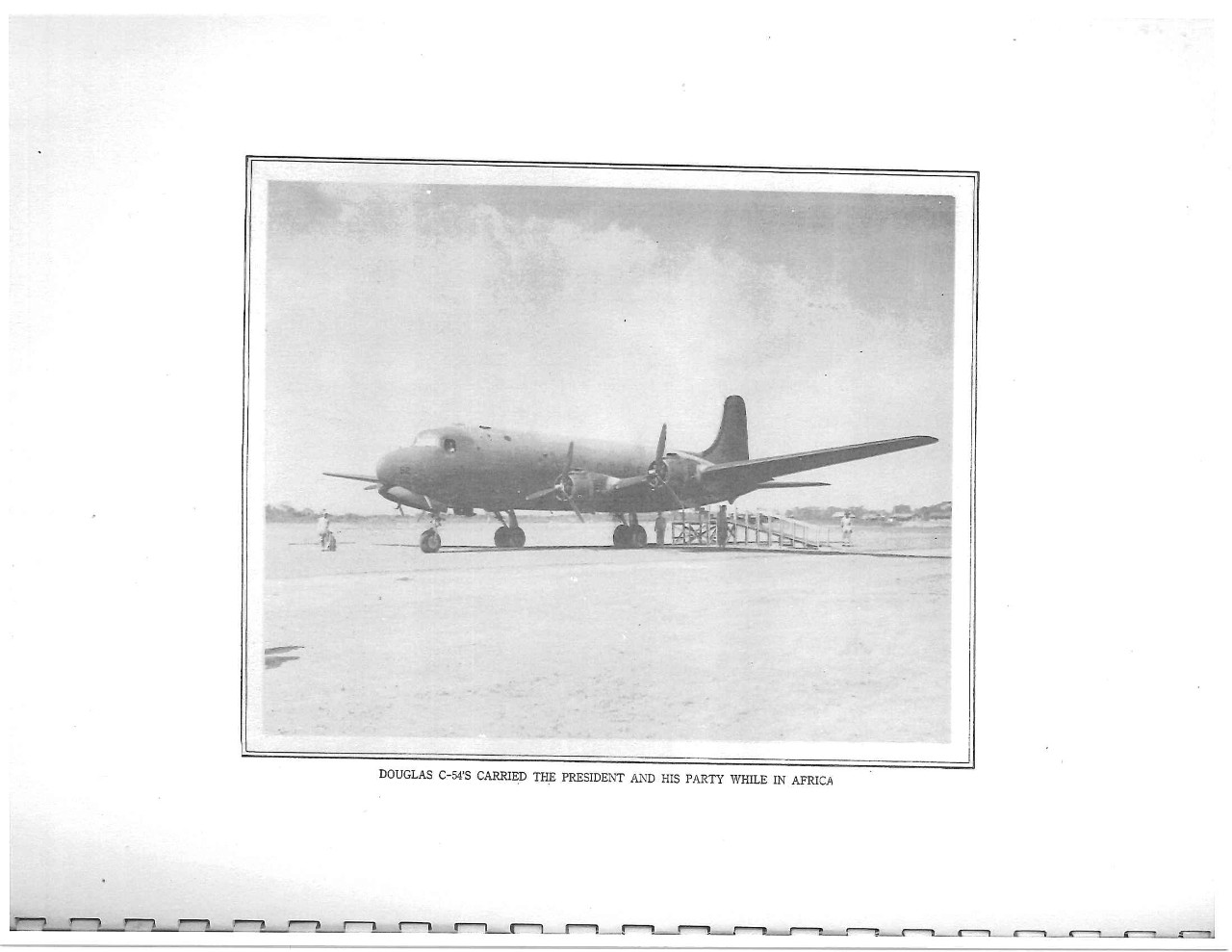
Thursday 14 January
Before daylight Captain Durno and Chief Ship’s Clerk Terry left the Memphis with the baggage and supplies which had been transferred from the two clippers to the Memphis during the evening. A Navy working party, had the motor sailer[sic] unloaded in jig time, and the truck provided by the Army was soon on its way to Yundum Field, about 18 miles outside Bathurst, where the Army Transport Command had two C-54’s waiting to transport the President and the rest of his party came into the Royal Air Force dock at Bathurst shortly after eight o’clock and rode in automobile to the airport.
The route to the flying field took the President through the main section of Bathurst where the natives were going about their morning chores. For the most party they were an ill-clothed, gum-looking lot, but it was given the party to understand that happier faces would not appear until after the chill and dews of the morning had been supplanted by the warmth of noonday. It was said that the prevailing wage rate for unskilled labor in this area was “one and nine” (1 shilling, 9 pence) per day, together with a half-cup of rice, the main article of diet for natives in this section of West Africa. Due to the prevalence of disease and general unsanitary conditions, the mortality rate is very high and life expectancy is only about 26 years.
Arriving at Yundum Field, the President was met by Brigadier General C. R. Smith, A.T.T.C., who had flown down from Casablanca with the two C-54 Army transport planes. This type plane, manufactured by the
-11-
Douglas Aircraft Corporation, is powered by four Wright 1200 horsepower motors, carriers 26 passengers and has a cruising speed of 180 miles per hour. The planes took off from Yundum Field at 8:58 A.M. local time, which is also Greenwich Meridian Time.
Normally the air route from Bathurst to Casablanca is entirely over land, but this flight was commenced by a swing to seaward and a turn to the north following the coastline in order to afford the President an aerial view of Daker and St. Louis, in Senegal, French West Africa. In passing Dakar the French battleship Richelieu was clearly observed alongside the quay wall as were several other ships at anchor in the harbor. After passing St. Louis the planes turned inland and for the next few hours passed over hundreds of miles of seemingly endless desert. In crossing the Atlas Mountains and approaching Marrakech, the cruising altitude of 8000 feet was insufficient, and it was necessary to increase altitude to about 11,500 feet.
The President’s plane landed at Medouina Airport, Casablanca, at 6:20 local time, where the President and the passengers in his plane were met by Mr. Michael Reilly of the White House Secret Service. The President proceeded by automobile to his villa adjoining the Anfa Hotel on the outskirts of the city. Here the American Army authorities had taken over a medium-sized modern hotel and 14 nearby villas. The entire area had been surrounded with barbed wire together with a heavy guard of troops, planes, and artillery. The hotel and the adjoining Villas had been organized to provide temporary headquarters for the President, the Prime Minister of Great Britain, and their respective staffs.
The President was installed in Villa No.2, “DAR es SAADA,”
-12-
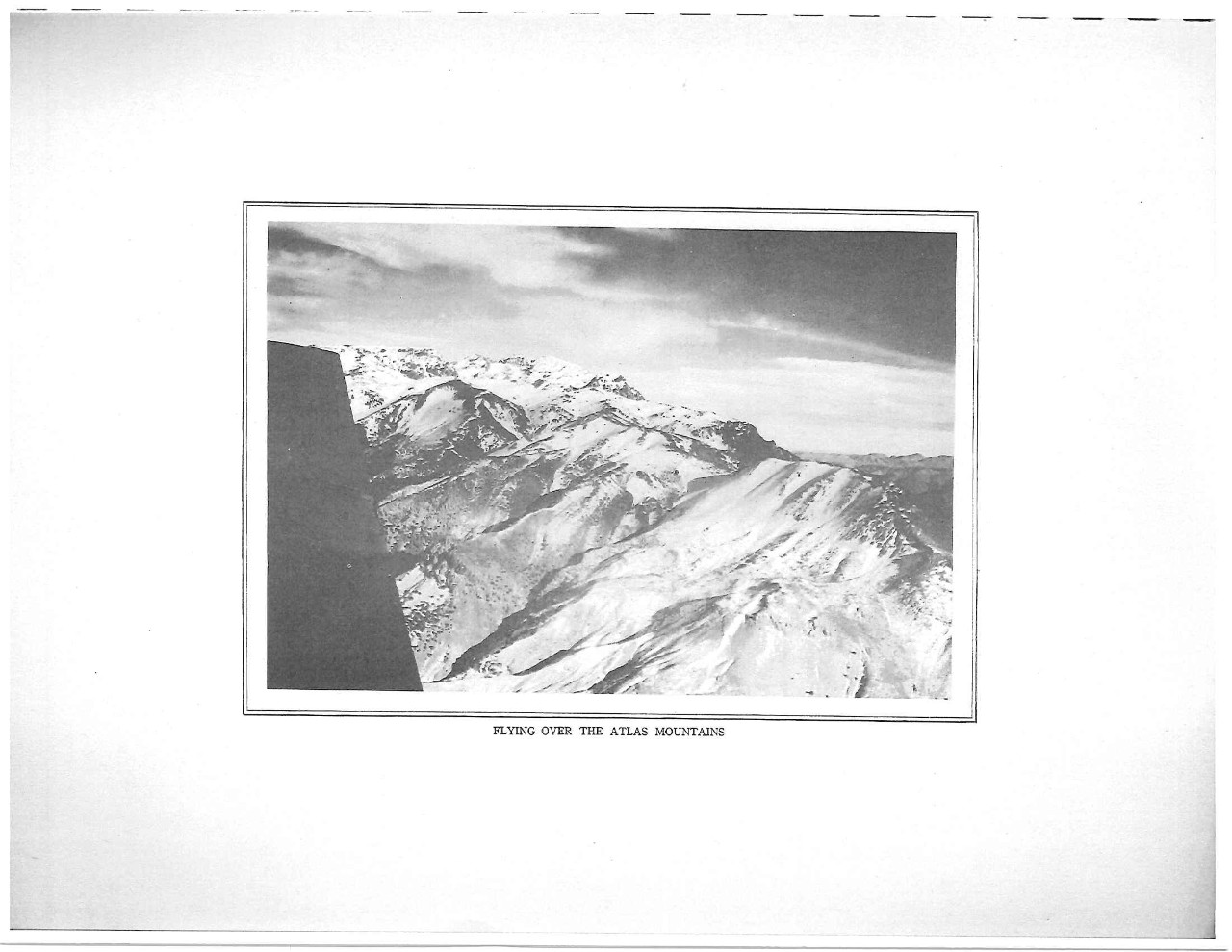
by 7:00 p.m., and a few minutes later Mr. Hopkins left for Villa No.3, “Mirador,” to escort Prime Minister Churchill across to the President’s villa. The President and Mr. Churchill conferred for an hour and then went in to dinner. In addition to Mr. Churchill, the following persons dined with the President:
General Sir Alan F. Brooke
Admiral of the Fleet Sir Dudley Pound
Air Chief Marshal Sir Charles Portal
Vice Admiral Lord Louis Mountbatten
General George C. Marshall
Admiral E.J. King
Lt. General H.H. Arnold
Lt. Colonel Elliott Roosevelt
Mr. Harry L. Hopkins
Mr. Averell Harriman
After dinner the President’s guest stayed late, renewing old acquaintances and “talking shop.” It was not until almost three hours after midnight that the President retired.
Friday 15 January
The day started with a long conference in the President’s bedroom. The following persons were present:
General George C. Marshall
Admiral E. J. King
Lt. General H. H. Arnold
Brig. General J. R. Deane
Mr. Harry Hopkins
Mr. Averell Harriman
This conference lasted from ten o’clock until 12:30. It was followed by a one-thirty luncheon in the President’s villa. Mr. Churchill, Mr. Harriman, Mr. Hopkins, Commander Thompson, and Lt. Colonel Elliott Roosevelt lunched with the President.
At 3:00 P.M. the Prime Minister and his personal aide, Commander
-13-
Thompson, took their departure in company with Mr. Harriman.
At 3:55 P.M. Lieutenant General Dwight D. Eisenhower, U.S.A., Commander U.S. Armed Forces in North Africa, called on the President. Shortly after five o’clock Mr. Robert D. Murphy, Special Representative of the President on the staff of the Commander-in-Chief North African Forces, visited the President and remained for ten minutes, departing at 5:30 P.M.
Preparatory to a conference of the Combined Chiefs of Staff scheduled for 5:30 P.M., the Prime Minister arrived at the President’s villa and introduced to the President the following listed British officers:
General H. R. L. G. Alexander, Commander Middle East Forces
Air Chief Marshal Sir Arthur Tedder
Lt. General Sir Hastings L. Ismay, Officer of the Minister of Defense
From 5:30 until 7:00 P.M. the following listed persons conferred as a group with the President and Prime Minister Churchill in the President’s villa:
Field Marshal Sir John Dill
General H. R. L. G. Alexander
General Sir Alan F. Brooke
Air Chief of Marshal Sir Arthur Tedder
Admiral of the Fleet Sir Dudley Pound
Air Chief Marshal Sir Charles Portal
Lt. General Sir Hastings L. Ismay
Vice Admiral Lord Louis Mountbatten
Brigadier E. I. C. Jacob
General George C. Marshall
Admiral E. J. King
Lt. General H. H. Arnold
Lt. General D. D. Eisenhower
Brig. General J. R. Deane
Following the departure of the above-listed conferees,
-14-
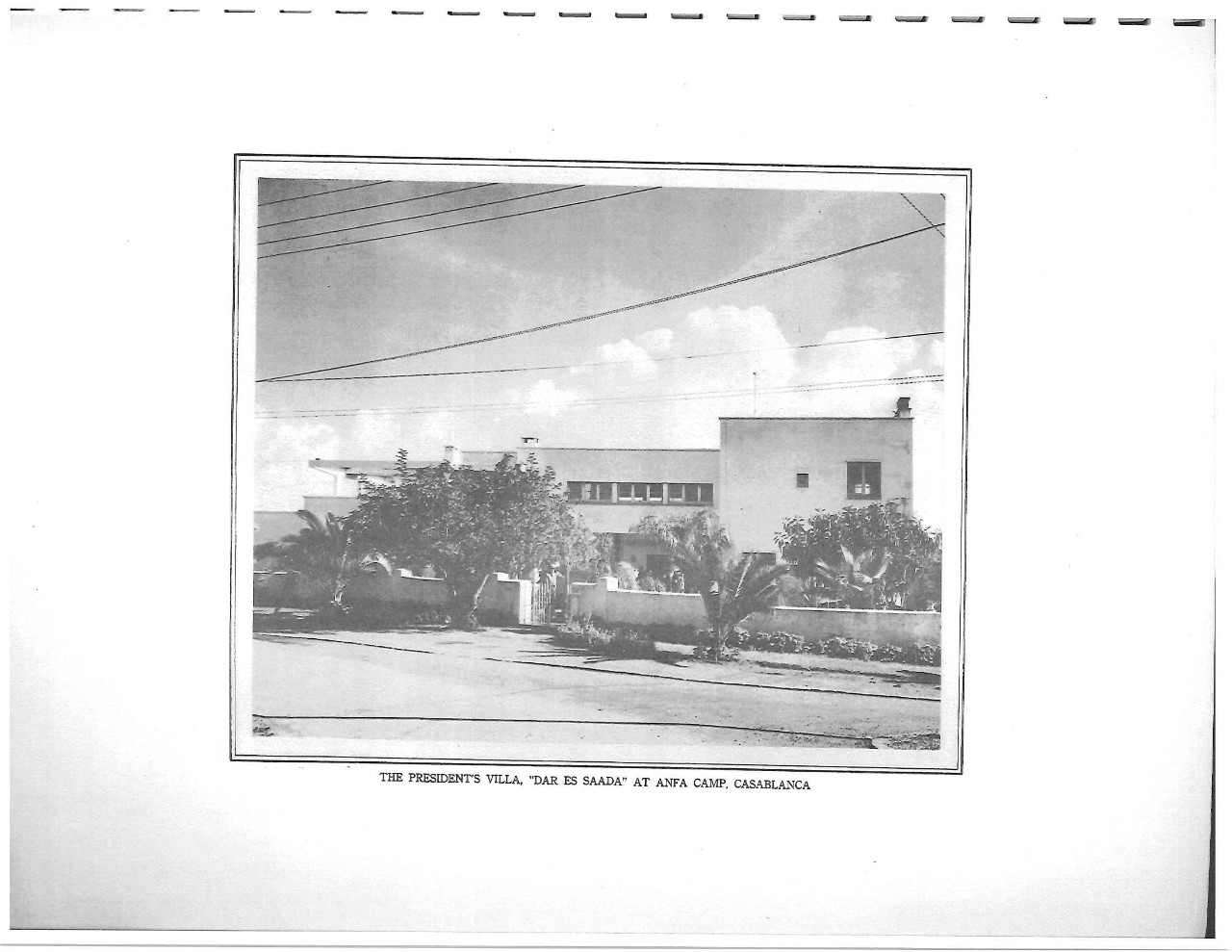
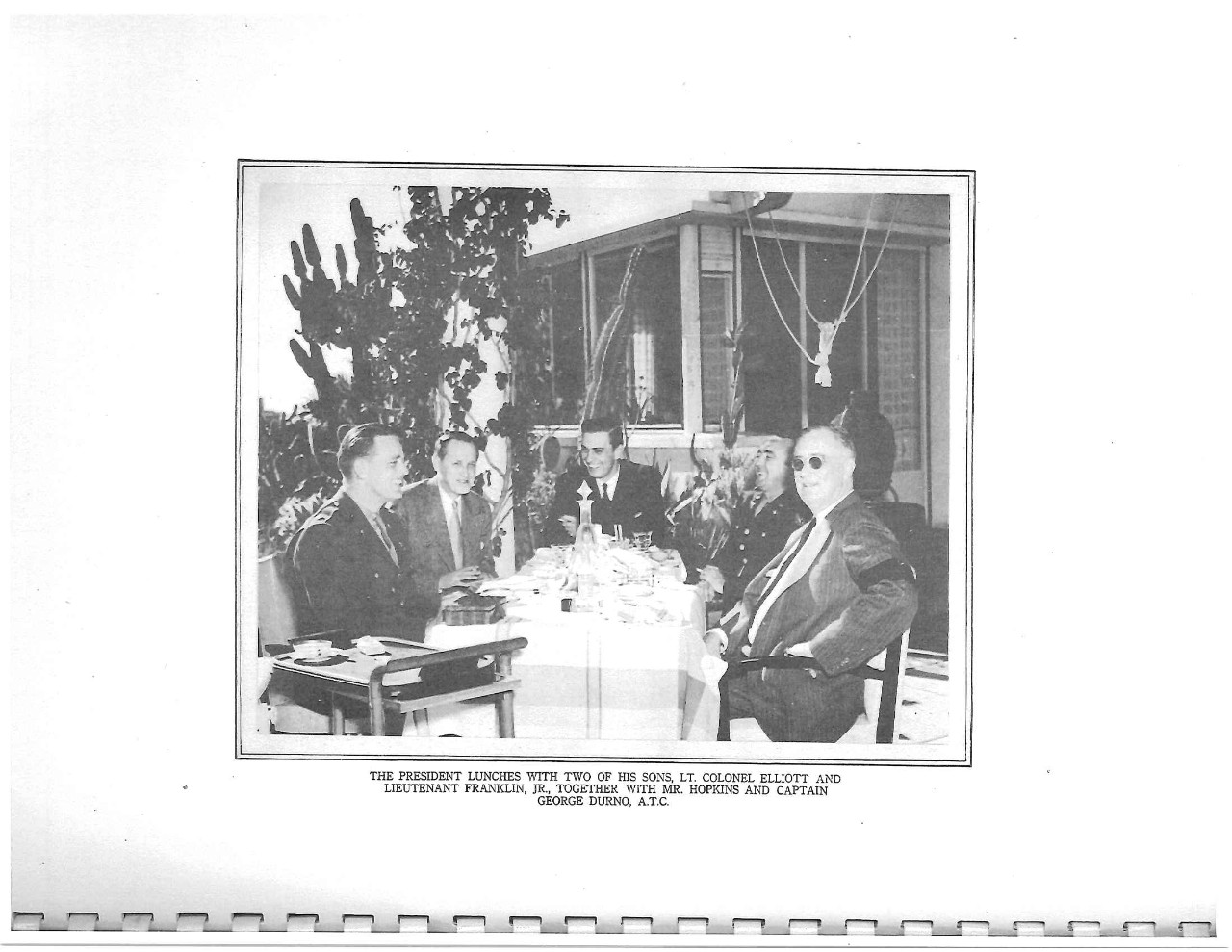
Mr. Harriman and Lord Leathers called on the President and remained for half an hour, departing at 7:35 P.M.
During the afternoon Lieutenant Franklin D. Roosevelt, Jr., U.S.N.R., had been informed of his father’s arrival at Casablanca, and he accordingly took up quarters in “DAR es SAADA,” thus making the household four persons – The President, Mr. Hopkins, Lt. Colonel Elliott Roosevelt, and Lieutenant Franklin D. Roosevelt, Jr. These four were joined at dinner in the President’s villa this evening by General Marshall, Lt. General Eisenhower, and Mr. Robert Murphy.
The President retired at 11:40.
Saturday 16 January
During the morning the President had number of callers, and, for the sake of brevity, they are indicated as follows:
| Called | Departed | |
| 9:55 | The Prime Minister | 11:25 |
| 10:45 | The Rt. Hon. H. MacMillan (Northwest Africa British Minister, resident at Allied Headquarters) | 11:20 |
| 10:50 | Mr. Robert Murphy | 11:20 |
| 11:00 | Lt. General Eisenhower | 11:15 |
The President, Mr. Hopkins, Lt. Colonel Elliott Roosevelt, and Lieutenant Franklin D. Roosevelt, Jr., were joined at luncheon today by Captain George Durno, Air Transport Command, who for many years before entering the Army, had covered the White House for the International News Service. Following luncheon, Chief Photographer’s Mate Black took some moving pictures and a number of still photographs of the luncheon party.
From 5:00 until 7:00 P. M. the following listed persons conferred with the President:
-15-
General George C. Marshall
Admiral E. J. King
Lt. General H. H. Arnold
Lt. General B. B. Somervell
Rear Admiral C M. Cooke, Jr.
Brig. General A. W. Wedemeyer
Brig. General J. R. Deane
Mr. Averell Harriman
The evening dinner party was somewhat unusual. Five members of the Women’s Army Auxiliary Corps (WAAC), had been invited to take dinner with the President, Mr. Hopkins, Lt. Colonel Roosevelt, Lieutenant Franklin D. Roosevelt, Jr., and Captain George Durno of the Air Transport Command. Their names are listed below:
Captain Louise Anderson WAAC
Captain Ruth Briggs WAAC
Captain Mattie Pinette WAAC
Captain Martha Rogers WAAC
Captain Alene Drezmal WAAC
At 11:00 P. M., upon invitation of the President, the Prime Minister, General Alexander, Mr. Harriman, and Commander Thompson joined what was now an after-dinner party, departing at two o’clock the following morning.
No doubt, it may be safely said that not even by the wildest stretch of the imagination, could any of these Service ladies have foreseen that one evening, in a country far from their native land, they would be dining with the President of the United States, and later would be joined by the Prime Minister of Great Britain.
Sunday 17 January
The first important caller of the day was M. General Charles A. Nogues, Resident General at Rabat, who had been met by Captain McCrea
-16-
upon arrival at Casablanca. The General was ushered into the President just at noon. General Nogues was accompanied by Major General G. S. Patton, Jr., Commanding General First Armored Corps; Brigadier General William H. Wilbur, First Armored Corps; and Mr. Robert D. Murphy, Special Representative of the President on the staff of the Commander-in-Chief North African Forces. Lt. Colonel Elliott Roosevelt was also present during this conference. At 12:45 General Nogues, accompanied by General Patton and Brigadier General Wilbur, withdrew to the Prime Minister’s villa. (Note: Conference notes, made by the Captain McCrea, recorded separately.)
Following the departure of General Nogues, the Prime Minister called at the President’s villa at 1:30 and remained for luncheon with the President and Mr. Hopkins, taking his departure at 2:50 P. M.
At 3:30 P. M. Lieutenant General Mark W. Clark, Commanding General Fifth Army, called on the President, to depart momentarily at four o’clock. At 4:15 P. M. he returned, escorting General Henri Giraud, Commander of the French Armies in North Africa, who had an appointment to confer with the President. The President conferred with General Giraud from 4:20 until 5:30, General Clark, Minister Murphy, and Captain McCrea also being present during this meeting. (Note: Conference notes, made by Captain McCrea, recorded separately.)
Upon the termination of the conference, General Giraud, General Clark, and Minister Murphy withdrew to the Prime Minister’s villa.
At eight o’clock in the evening, the Prime Minister, Lord Leathers, Admiral Cunningham, Admiral King, Lt. General Somervell, and Mr. Harriman dined with the President and his household. Following
-17-
dinner the main subject of the conversation was “shipping,” lasting until one o’clock in the morning when the President’s dinner guests took their leave.
Monday 18 January
The President’s morning callers were Lieutenant General Mark W. Clark, Commanding the Fifth Army, who arrived at 10:05 and departed at 11:10; Mr. Robert D. Murphy, who conferred with the President and Mr. Hopkins from 10:45 until 12:45; and General C. Marshall, who called at 12:45 and departed five minutes later.
The Prime Minister lunched with the President, Mr. Hopkins, and Lt. Colonel Elliott Roosevelt at “DAR es SAADA” at 1:15 P. M. and departed at 2:40.
The President left the grounds of his villa for the first time at 4:10 this afternoon. He embarked in a jeep to inspect a guard mount of the Third Battalion of the Thirtieth Infantry guarding the President’s camp.
With Major General G. S. Patton, Jr., Commanding General First Armored Corps, and Lt. Colonel C. E. Johnson, the Commanding Officer of the Third Battalion in the rear seat of the President’s jeep, the small cavalcade of cars set off for the encampment area, a stone’s throw from the President’s villa.
Upon arriving at the camp the President was driven along the rows of “pup tents” in which the Battalion was quartered, two men t a tent, and was afforded an opportunity to view at close hand the various arms and equipment normally carried by an infantry battalion. Machine
-18-
guns, AA guns, trench mortars, etc., were “laid out for inspection.”
The President and his party then proceeded to a small open area which might best be described as the Battalion parade ground. For the next twenty minutes two platoons of infantry went through the various evolutions of a guard mount and brought it to a close by marching in review past the President, preceded by the band of the 36th Engineers, which rendered several stirring military numbers. It could not help but be noticed that the largest musician in the band, who must have weighed at least 275 pounds, was playing a very small flute, which probably weighed four ounces.
Upon the conclusion o9f the guard mount and review, the President thanked General Patton and Lt. Colonel Johnson and remarked that the evolution was “awfully nice” and “very good.”
It was a field day for the local host of Army photographers and the lone Navy Chief Photographer brought with the Presidential party from Washington.
The President returned to his villa at 4:50, for the Combined Chiefs of Staff were scheduled to confer with him, starting at five o’clock.
The following American and British military representatives of their respective Army, Navy, and Air Forces, conferred with the President, the Prime Minister, and Mr. Hopkins from 5:00 until 6:30 P. M. :
Field Marshal Sir John Dill
General Sir Alan F. Brooke
Admiral of the Fleet Sir Dudley Pound
Air Chief Marshal Sir Charles Portal
Lt. General Sir Hastings L. Ismay
Vice Admiral Lord Louis Mountbatten
Brigadier E. I. C. Jacob
-19-
General George C. Marshall
Admiral E. J. King
Lt. General H. H. Arnold
Brig. General J. R. Deane
Shortly before seven o’clock Mr. Hopkins had the pleasure of seeing his son, Sergeant Robert Hopkins, who had secured leave of absence from the Signal Corps company to which he was attached and which was then engaged in active operations at the front. Sergeant Hopkins went in to pay his respects to the President, and later his father took him to call on the Prime Minister.
Mr. Murphy called just before dinner, but stayed with the President only about five minutes, departing at 7:45.
Mr. Hopkins had accepted an invitation to dine with General Patton this evening, and so he was not present when the President, Lt. Colonel Elliott Roosevelt, and Lieutenant Franklin, Jr., sat down to dinner with their guests for the evening, Admiral McIntire, Captain McCrea, and a young Army officer, Lieutenant Richard Ryan, a grandson of Thomas Fortune Ryan, and a friend of the family.
The President retired about eleven o’clock.
Tuesday 19 January
As it was necessary for him to get back to his ship by ten o’clock, Lieutenant Franklin D. Roosevelt, Jr., U. S. N. R., departed the President’s villa at 9:20 A.M. after breakfasting with his brother, Elliott, Mr. Hopkins and Sergeant Robert Hopkins.
During the morning Mr. Harriman and Mr. Robert Murphy were in conference with the President and Mr. Hopkins, as was Air Chief Marshal
-20-
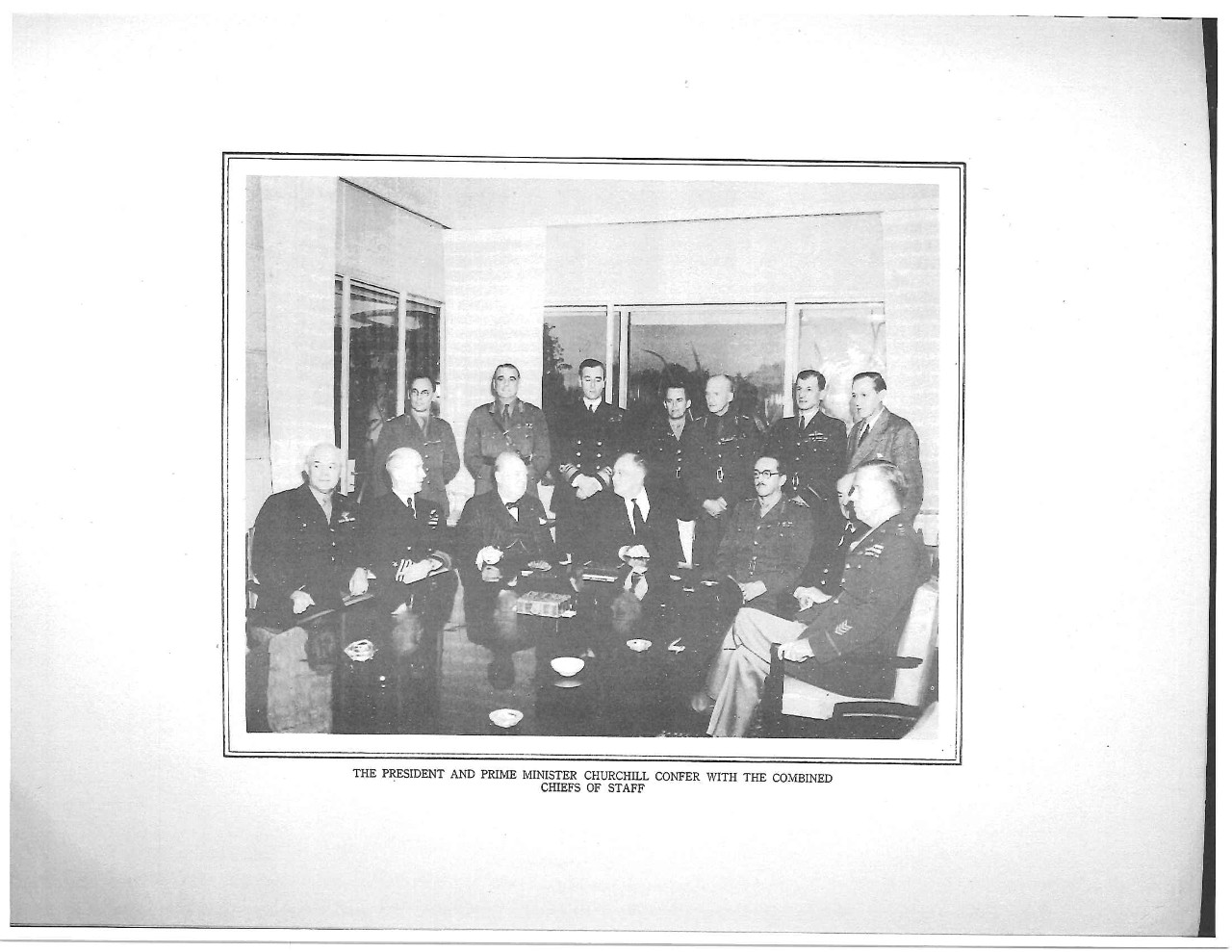
Sir Arthur Tedder, who saw the President from 11:25 until 11:45.
The President held a second conference with General Henri Giraud, commencing at noon. Mr. Hopkins, Mr. Robert D. Murphy, Captain John L. McCrea, Lieutenant Colonel Elliott Roosevelt, and Captain A. Beaufre, Aide-de-camp to General Giraud, were also present. The conference touched on a number of pints, the details of which are set forth in notes taken by Captain McCrea and which have been recorded separately. At 12:40 the President and General Giraud withdrew to the terrace where motion and still pictures were made of time. Later the President directed Mr. Hopkins, Captain McCrea, and Captain Beaufre to join the group and additional pictures were made. The General and his aide departed at 12:50 P. M.
The President, Mr. Harriman, Mr. Hopkins, Lt. Colonel Elliott Roosevelt, and Sergeant Robert Hopkins lunched together today, following which General Patton called to take Mr. Hopkins and Lt. Colonel Elliott Roosevelt downtown to shop and souvenir hunt and make an automobile tour of the waterfront and the business district of Casablanca.
During the afternoon Lt. General H. H. Arnold called on the President. He was followed by Rear Admiral J. L. Hall, U. S. N., Commander Western Task Force Sea Frontier, who departed at 4:30 P. M.
At 5:30 P. M., the Prime Minister and his son, Randolph Churchill, a Captain in a Special Service Brigade (Commandos), paid a call on the President and chatted until 6:20, when they left to return to “Mirador.”
Mr. Hopkins and his son, Robert, together with Mr. Harriman left the villa about 7:30 to take dinner with the Prime Minister and his son, Randolph. At this time the President, Captain McCrea, and Lt.
-21-
Colonel Elliott Roosevelt also left the villa to have dinner with Major General G. S. Patton, Jr., Commanding General First Armored Corps, at “Villa Nas,” General Patton’s headquarters. Also dining with the President and General Patton this evening were Rear Admiral C.M. Cooke, Jr., U. S. N.; Major General Geoffrey Keys, Deputy Commanding General, W. H. Wilbur, in charge of Special Activities in the area now occupied by the First Armored Corps; Brigadier General John E. Hull; and Colonel H. R. Gay.
The President returned to “DAR es SAADA” at 11:15 P. M., and at 11:20 P. M. the Prime Minister came in to chat with the President, M. Hopkins, and Lt. Colonel Elliott Roosevelt until 1:00 A. M. the next morning, when the Prime Minister returned to his villa.
The President retired about 1:30.
Wednesday 20 January
Lieutenant General Somervell arrived at Villa “DAR es SAADA” at eight o’clock this morning to breakfast with Mr. Hopkins, and departed one hour later. Major General Spaatz called at ten o’clock to keep an appointment with the President and departed at 11:30. Mr. Robert Murphy also spent an hour at the President’s villa this morning conferring with the President and Mr. Hopkins.
At 11:35 General Marshall, Lt. General Arnold, Lt. General Somervell, and Admiral E. J. King arrived for a conference with the President, and following this conference they were photographed on the terrace with the President, together with Mr. Hopkins and Mr. Harriman. After the photographs and been taken, the aforementioned Army and Navy
-22-
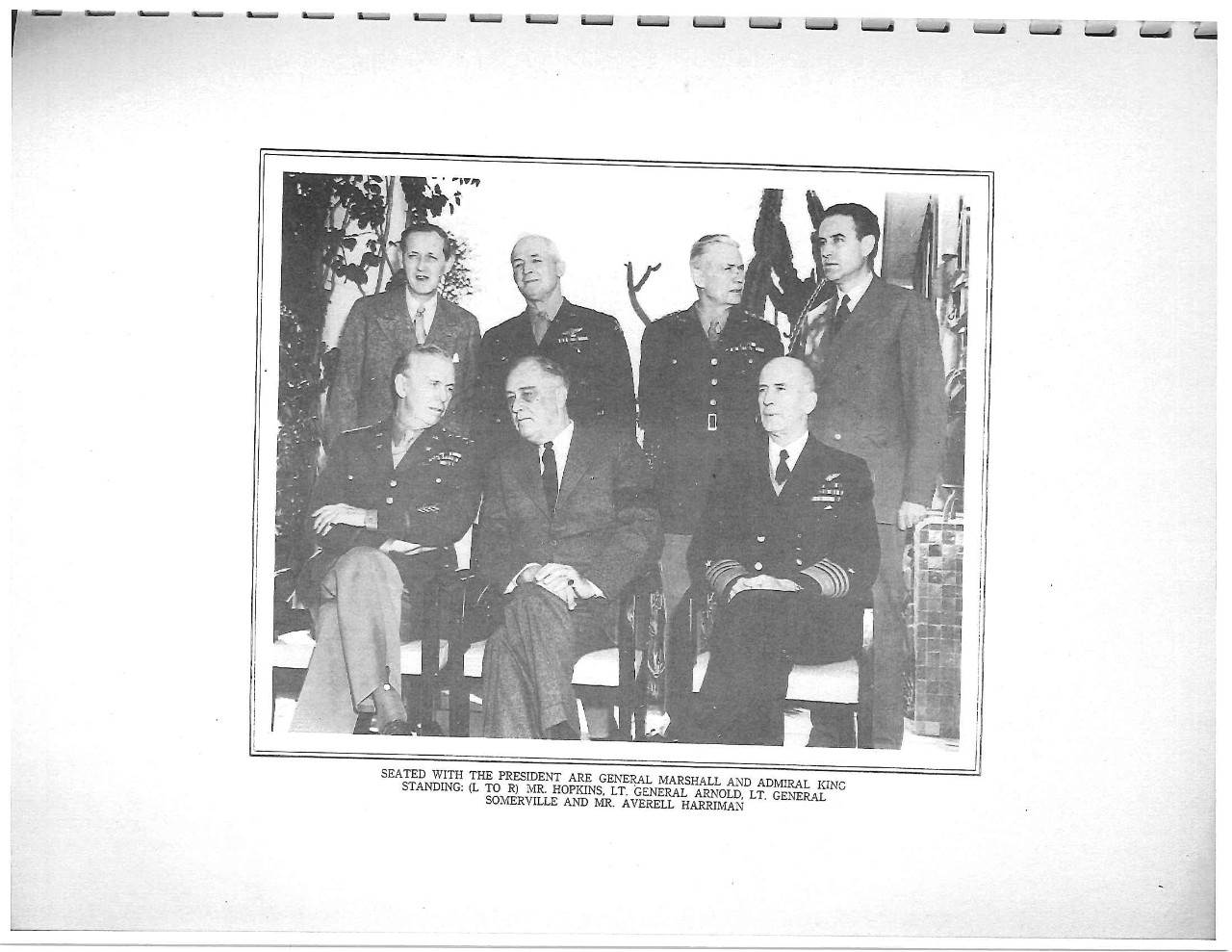
officers departed, about 12:30.
Shortly after 1:00 P. M. the Prime Minister, Mr. Harriman, Mr. Murphy, and Mr. MacMillan called to have lunch with the President, Mr. Hopkins, and Lt. Colonel Elliott Roosevelt, and departed just before 3:00 P. M.
At 5:00 P. M. the Prime Minister returned in company with General Giraud, and the
General’s Civilian Aide, M. Poniatowski, and went into conference with the President, Mr. Hopkins, and Mr. Murphy until 5:55, when they took their departure.
At 7:45 the President left Villa “DAR es SAADA” to dine as the guest the Prime Minister this evening were:
General H. R. L. G. Alexander
Sir Charles Wilson
Mr. T. L. Rowan (Private Secretary to the Prime Minister)
Mr. J. M. Martin (Private Secretary to the Prime Minister)
Mr. Harry Hopkins
Mr. Averell Harriman
Lt. Colonel Elliott Roosevelt
Commander Thompson (Aide to the Prime Minster)
Captain Randolph Churchill
Sergeant Robert Hopkins
The President returned to his villa about 11:15 P. M. and retired shortly thereafter.
Thursday 21 January
The President arose early this morning, breakfasted, and left Casablanca by automobile at 9:20 for an inspection of the United States Army forces stationed in the vicinity of Rabat, some 85 miles to the
-23-
northeast. He was accompanied by Major General G. S. Patton, Jr., Commanding General First Armored Corps; Mr. Hopkins; Mr. Harriman; Mr. Robert D. Murphy; and Rear Admiral Ross T. McIntire. Captain McCrea had gone on ahead to Rabat by automobile, accompanied by Brigadier General W. H. Wilbur, to deliver in person a letter from the President to the Sultan of Morocco inviting the Sultan and his entourage to take dinner with the President at Casablanca on 22 January. Captain McCrea joined the President’s party upon arrival at a point about five miles to the north of Rabat, where the President was to begin his inspection.
Upon leaving the area the entourage passed huge gasoline dumps where hundreds of thousands of gallons of gasoline were stored in widely-scattered groups of 50-gallon steel drums, about 400 to a pile. Each pile would thus represent about 20,000 gallons of gasoline, or roughly two tank-car loads. At least a millon gallons of gasoline were stored in this area for use by Army aircraft and motor vehicles operating in French Morocco.
The President’s sedan was preceded by a motorcycle unit or military police, a jeep and a reconnaissance car, the rest of the party being in Army cars just behind the President. To the rear two trucks of heavily-armed troops, two more reconnaissance cars, and an additional motorcycle detail made up the cavalcade. Overhead, for the entire trip northward along the coastline and during the return to Casablanca, an escort of fighter planes maintained vigil.
After passing Ralentir airport, on the outskirts of Casablanca, it was noticed that small detachments of American troops were billeted in every suitable building.. A moving picture studio, formerly operated
-24-
by the French company, “Cineophone,” was occupied by a unit of the Army Signal Corps. The Germans had made use of this studio subsequent to the fall of France and prior to the arrival of the American forces.
The country passed on the way to Rabat was devoted chiefly to dairy farming, grazing, fruit raising and truck farming. The greater part of the mud, stone and thatched huts and shacks in which the herders and farmers lived were not very impressive. The buildings and houses were similar to the “Bonus Army” type of structure, which sprawled on Anacostia Flats in Washington some years ago.
During the early part of the trip, the party passed several units of French Moroccan infantry and cavalry carrying out training exercises of various types. About ten o’clock a few miles out of Casablanca, we passed an ammunition dump where bombs and other munitions were stored in widely-scattered piles, ready for use by our forces in the vicinity. At 10:30, when passing close to the shore line, four small vessels were observed stranded on the beach.
The road traveled was macadamized and could generally be classed as “good,” in comparison with the average highway to be found in the United States. With the exception of a few spots, where repairs were being made, no detours were encountered.
The outskirts of Rabat were reached at 11:15. After driving around the old walls of the city, the cavalcade continued northward.
At 11:30, a few miles to the north of Rabat, the President stopped and transferred from his touring sedan to an Army Jeep, in which he rode during the inspection of the Second Armored Division and the Third Division of Infantry.
-25-
At this time the President was joined by Lt. General Mark W. Clark, Commanding General Fifth Army, and Major General Ernest Harmon, Commanding the Second Armored Division. After honors had been rendered, the President’s jeep moved forward along the highway, to the right of which the personnel and equipment of the Second Armored Division had been drawn up for inspection. Here the President saw light, medium, and heavy tanks, half-tracks that carried a three-inch gun forward and a .50 caliber machine gun in the rear, as well as hundreds of combat and reconnaissance cars. The crew of each tank or car was drawn up alongside, their numbers ranging from four to seven men depending on the size and type of the equipment.
Staff Sergeant O. E. Lass, of the 89th Ordnance Company, First Armored Corps, chauffeured the President’s jeep during this inspection.
Upon completing the inspection of the Second Armored Division, General Harmon dismounted from the President’s jeep, and his place was taken by Major General Jonathan Anderson, whose command, the Third Infantry Division, was about to be inspected by the President.
The men of this Division all looked fine, healthy, and as if spoiling for action. The President drove very slowly along the assembled troops which were formed along the roadway in three ranks for a distance of about a mile, and make a careful inspection of this Division. The inspection was completed at 12:05.
After President finished his inspection of the Third Division, the party left the highway and proceeded to an open area nearby where about 25 tables had been set up near an Army field kitchen. The noonday meal was about to be served to the President and the members of
-26-
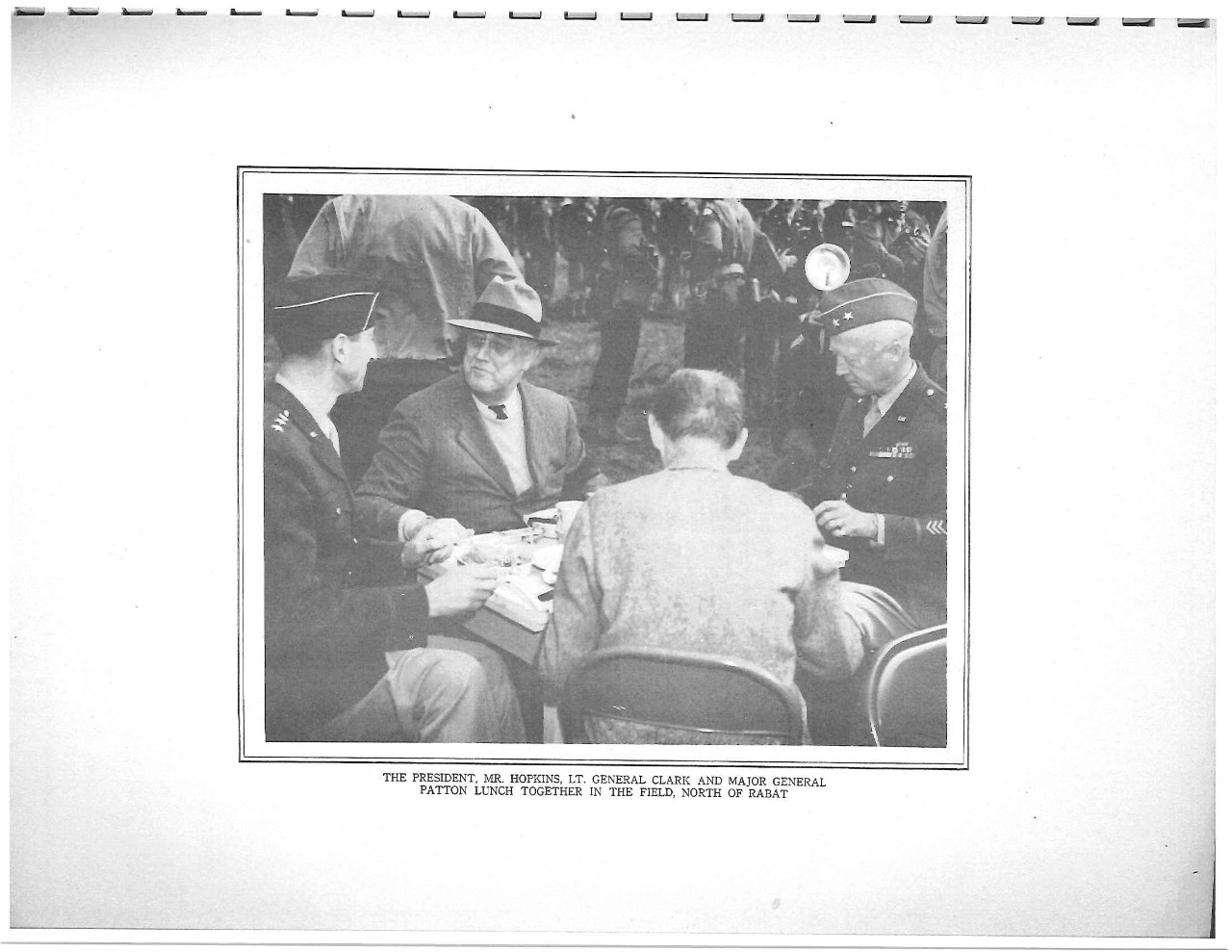
his party.
After disembarking from his jeep, the President received a representative group of officers and men from the Second Armored Division, and like number from the Third Division, all of whom, with two exceptions, had been decorated with the Order of the Silver Star for gallantry in action during the struggles which had taken place recently at Mehdia, Safi, Port Lyautey, Tleta, and during landings in the heavy surf. The two exceptions were Sergeant Sanford F. Forbes, Seventh Infantry, and Lt. Colonel Harry H. Semes, who had been awarded the Distinguished Service Cross for extraordinary heroism in the face of an armed enemy. It was the third time Lt. Colonel Semes had been so decorated. The 50 officers and men whom the President greeted by no means represented the total number of those in the two Divisions who had distinguished themselves during recent operations, but, indeed, were a representative group.
Boiled ham, sweet potatoes, green string beans, fruit salad, bread, butter, jam and coffee were served in the field. While the Commander-in-Chief ate in the open air close to some 20,000 men of the North African Forces, the Third Division Artillery Band, under the leadership of Warrant Officer Peter Parkinson, rendered such tunes as, “Chattanooga Choo-Choo,” “Missouri Waltz,” “Naughty Waltz,” “Deep in the Heart of Texas,” and “Alexander’s Ragtime Band.”
The party left camp at 1:00 P.M. to the strains of the Field Artillery song, “The Caissons Go Rolling Along.” At 1:20, the President again left his sedan for a jeep to inspect the Ninth Infantry Division commanded by Major General Manton S. Eddy. This inspection was completed at 1:55. The greater part of this unit, including three battalions of
-27-
infantry, combat cars, jeeps, half-tracks, tanks and motorized artillery, passed in review before the President.
Following the inspection of the Ninth Division, the party proceeded further northward. In passing through Port Lyautey several sunken ships were observed in the harbor. About five minutes out of Port Lyautey, the President stopped at 2:15 to view Fort Mehdia, an ancient stone fortress which has been many times besieged in its long history.
Close to this old fort was newly-established military cemetery, located on a rise of ground overlooking Port Lyautey, where eight officers and 80 American men were buried, casualties of the Battle of Mehdia and the Battle of Port Lyautey, 8-11 November 1942. On behalf of the President, Lieutenant General Clark and Captain McCrea placed a wreath in the American section of this cemetery and also laid another in the cemetery’s French park, where a number of recent casualties among French officers and men had been laid to rest.
After proceeding but a short distance from the cemetery, the President again stopped for a few minutes while Colonel Frederick DeRohan, U. S. Army, using a large scale chart which had been especially prepared for this occasion, explained to the President the various phases and operations of the battle for Port Lyautey.
The weather, which up until now had been windy and cool, commenced to threaten, and the President said that he was “ready to go home.” On the return trip to Casablanca rain was encountered during the last 50 miles.
The President reached his villa in Casablanca at 5:20 P. M. He had been gone eight hours on his tour of inspection, traveling
-28-
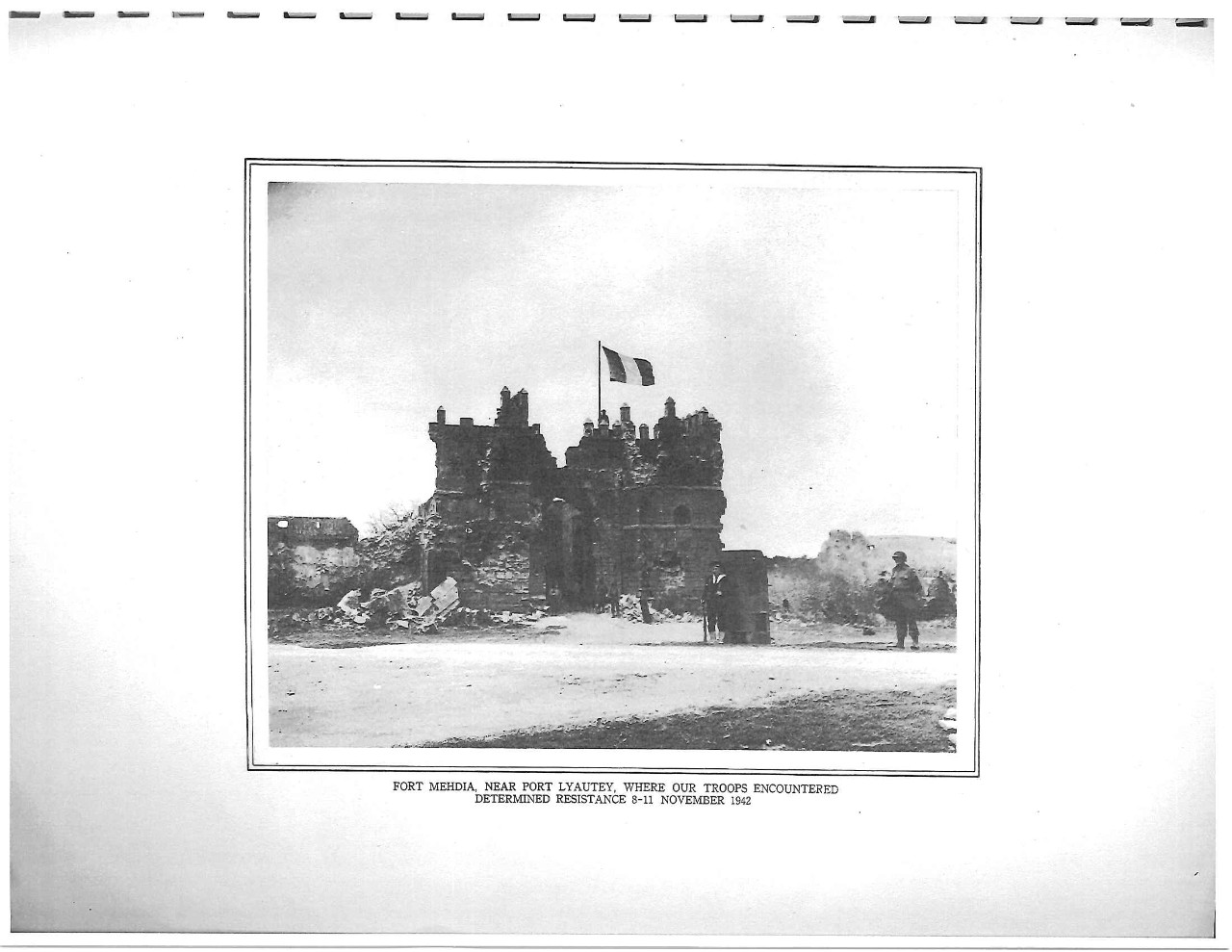
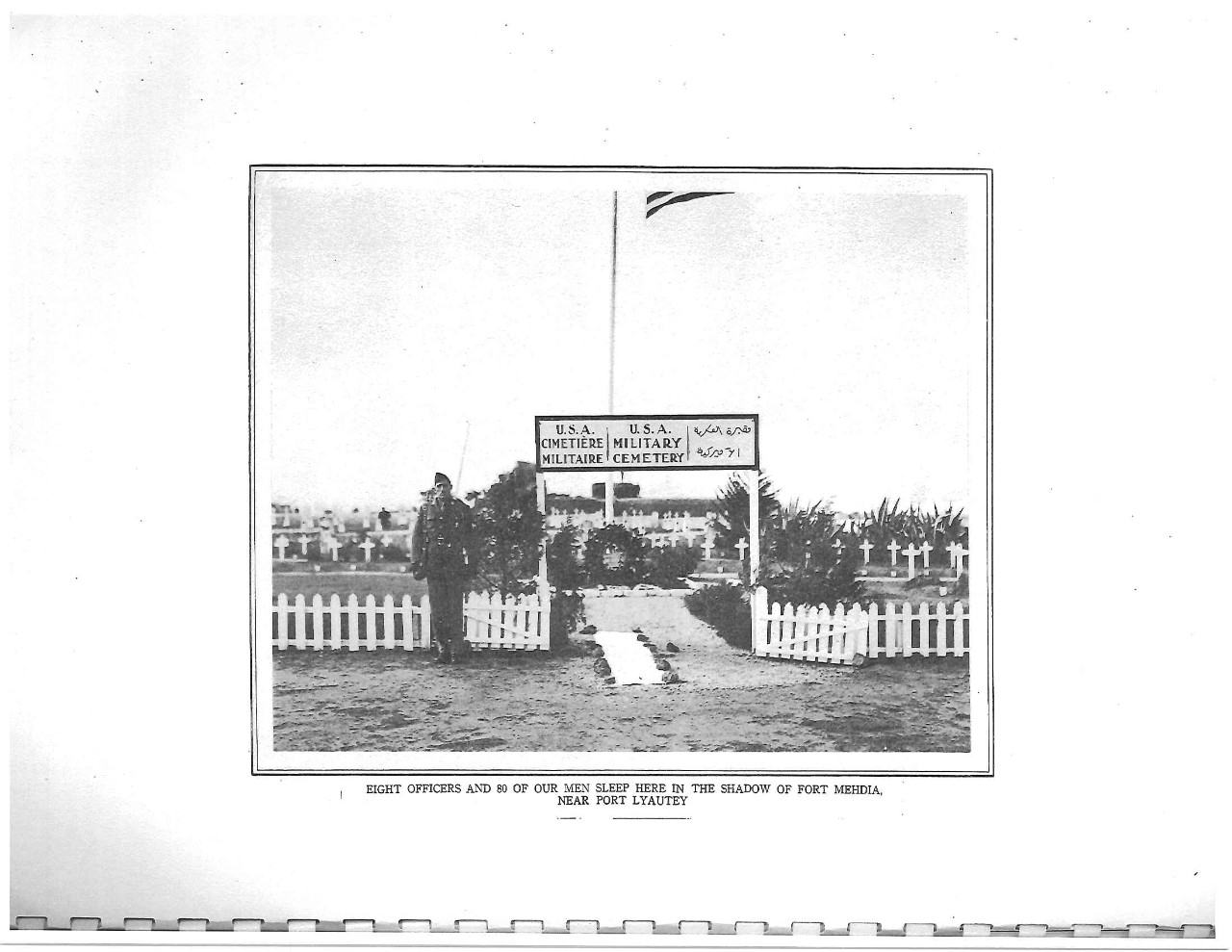
approximately 200 miles by automobile.
Following the President’s return to his villa at Casablanca, the Prime Minister called and remained with the President for an hour, departing at 7:25 P.M. Dinner was a comparatively small affair, Admiral McIntire and Captain McCrea dining with the President, Mr. Hopkins, Sergeant Robert Hopkins, and the President’s son, Lt. Colonel Elliott Roosevelt. The President said that he had enjoyed himself immensely during this day in the open. He retired shortly after 9:30 for his longest night’s rest since arriving in North Africa.
Friday 22 January
Mr. Hopkins was in conference with the Prime Minister from 9:45 until 11:55 A.M., returning just before noon in order to be present when the President and the Prime Minister were photographed with the Combined Chiefs of Staff. Several photographs were taken on the terrace of the President’s villa, and then the President bestowed the Congressional Medal of Honor on Brigadier General William H. Wilbur, U.S. Army, for conspicuous gallantry and intrepidity in action during the landing at Fedala on 8 November 1942. Under heavy fire, General Wilbur had succeeded in passing through the French lines in order to deliver certain important letters to French generals some 16 miles to the rear, and later, while returning to his own troops, had personally led a group of tanks which destroyed a French artillery unit observed to be effectively shelling our positions. The President made the presentation in the presence of the Prime Minister, General Marshall, and General Patton, and upon the conclusion of the ceremony extended his personal congratulations to
-29-
General Wilbur, as did the Prime Minister and Vice Admiral Lord Louis Mountbatten.
The President and General Marshall lunched together at the President’s villa, no others being present. General Marshall departed at 2:30 P.M.
During the late afternoon Mr. Harriman and Mr. Murphy conferred with the President and Mr. Hopkins, separately and jointly.
The Sultan of Morocco had taken great pleasure in accepting the President’s dinner invitation which Captain McCrea had delivered at Rabat the day before. He arrived at the President’s villa at 7:40 together with his early teenage son, the Heir Apparent, the Grand Vizier, and his Chief of Protocol.
The Sultan and his entourage were magnificently attired in white silk robes and came bearing several presents – a gold mounted dagger for the President in a beautiful inlaid teakwood case, and two golden bracelets and a high golden tiara for Mrs. Roosevelt. The President presented the Sultan with a personally-inscribed photograph of himself, in a beautiful heavy silver frame, engraved at the top with the seal of the President of the United States.
No alcoholic beverages were served before, during or after the dinner, and care had been taken that no pork or pork products were served since these items are forbidden to true Mohammedans.
The dinner list was composed of the following persons:
The President
The Sultan of Morocco (on the President’s right)
The Prime Minister of Great Britain (on the President’s left)
General Charles A. Nogues, Resident General
-30-
The Grand Vizier to the Sultan
Major General Patton
Mr. Robert Murphy
The Crown Prince of Morocco
The Chief of Protocol
Mr. Hopkins
Captain McCrea
Lt. Colonel Elliott Roosevelt
The Sultan and his party left at 10:10 P.M. and were followed shortly thereafter by the Prime Minister, General Nogues, and General Patton.
General Charles DeGaulle had arrived in Casablanca from London at noon today, had lunched with General Giraud, and at 6:30 P.M. had kept an appointment with Prime Minister Churchill. These two conferred until the latter had to depart for dinner with the President and the Sultan of Morocco. General DeGaulle talked with the President from 10:20 until 10:55 P.M. Information as to the substanvce of the conversation between the President and General DeGaulle is contained in notes recorded separately by Captain McCrea.
Following the departure of General DeGaulle at 10:55, the Prime Minister and Mr. MacMillan, plus the latter’s secretary, Mr. Mack, called on the President at 11:15 and conferred with him, Mr. Murphy, and Mr. Hopkins until 12:30 A.M.
The President retired a half hour after the Prime Minister, Mr. Murphy, Mr. MacMillan, and Mr. Mack departed.
Saturday 23 January
Mr. Hopkins and had a number of callers during the morning, conferring at various times with Lt. General Arnold, Mr. Harriman, and Major
-31-
General Patton.
The Prime Minister lunched with the President, Mr. Hopkins, and Lt. Colonel Elliott Roosevelt at 1:30 P.M. He departed at 2:45 P.M.
Mr. Murphy and Mr. MacMillan called during the afternoon at 3:50 and departed at 4:10, again calling at 4:30 and leaving at 5:15.
The Prime Minister arrived at the President’s villa at 4:45 to talk with the President prior to a final meeting of the Combined Chiefs, of Staff scheduled for 5:30. The American and British military, naval, and air chiefs conferred with the President and the Prime Minister, in the dining room of the President’s villa from 5:30 until 7:50 P.M. This was the last large-scale meeting of the ten-day conference period fast drawing to a close.
There were no guests at dinner tonight. The President and Mr. Hopkins dined with their sons, Lt. Colonel Elliott Roosevelt and Sergeant Robert Hopkins.
After dinner Mr. Murphy, Mr. MacMillan and Mr. Mack called to see Mr. Hopkins, and at 10:30 the President sent for Chief Ship’s Clerk Terry to dictate some “background material” which the President planned to give to the correspondents who were to attend the press conference scheduled for 11:00 A.M. the following day.
When Mr. Terry returned shortly after midnight with the transcript of the President’s dictation, he found the Prime Minister and his son, Randolph, in conference with the President and Mr. Hopkins.
In the next two hours the final draft of a cable to Mr. Stalin, reporting the highlights of the meeting, was agreed upon, as was also the text of the joint communique to be issued next day to the press
-32-
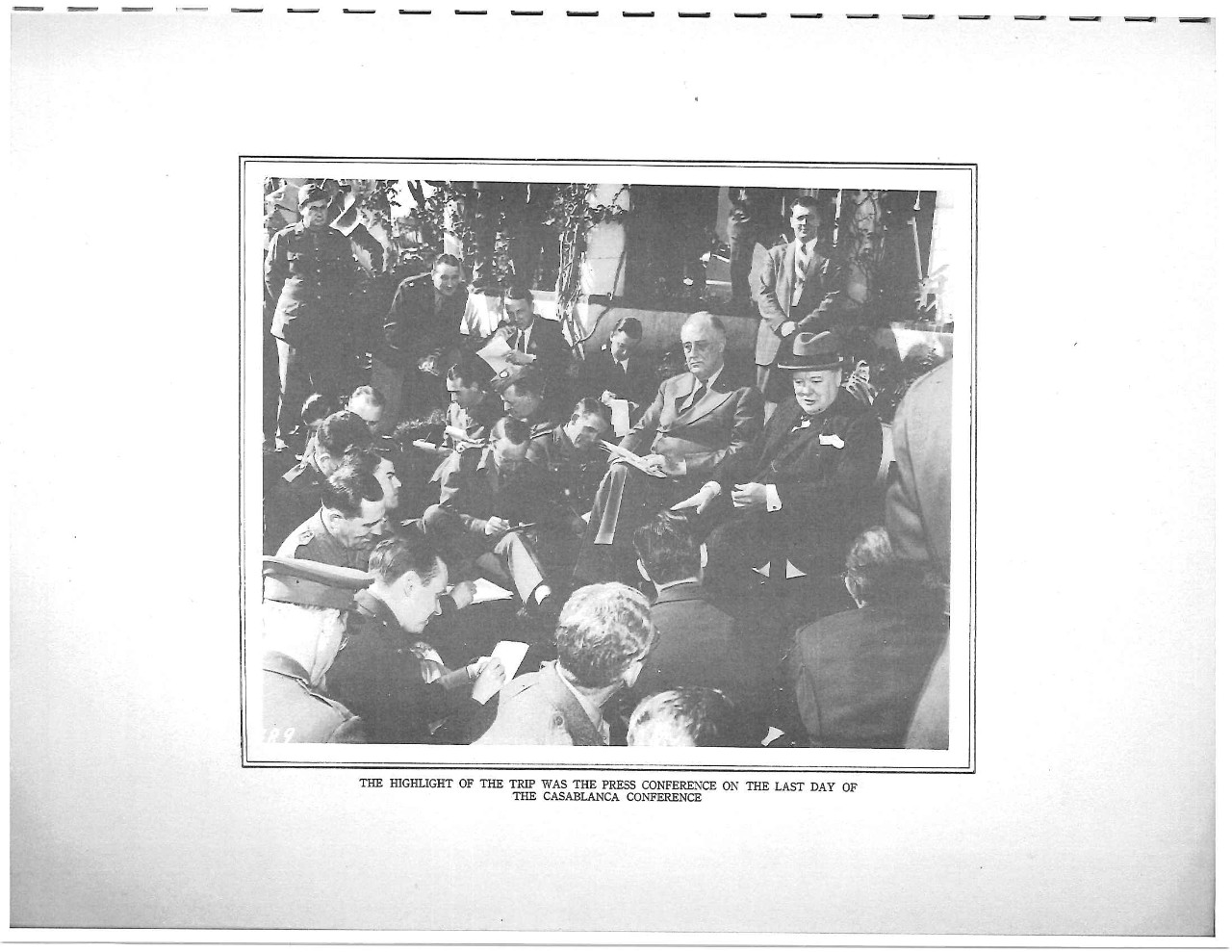
representatives for actual release to the press of the world the following Wednesday.
Mr. Murphy, Mr. MacMillan, and Mr. Mack left the President’s villa at 2:10 A.M., and the Prime Minister and his son took their departure at 2:30. The President retired a few minutes later.
Sunday 24 January
General Henri Giraud called at 11:05 and had an audience with the President until 11:40. Major General Charles DeGaulle had arrived while General Giraud was in conference with the President, and following General Giraud’s departure, went in to talk to the President, Mr. Hopkins, Mr. Murphy, and Mr. MacMillan.
While General DeGaulle was with the President, General Giraud returned, and a few minutes later the Prime Minister appeared.
These four, the President, the Prime Minister, General Giraud, and General DeGaulle then repaired to the lawn in the rear of the President’s villa where they posed for moving and still pictures. While the cameras “turned over”, the two generals shook hands.
Then Generals Giraud and DeGaulle bade farewell to the President and the Prime Minister and withdrew.
A few minutes after twelve the President, with the Prime Minister seated at his left, invited the assembled newspapermen to sit down on the lawn and make themselves comfortable for the discussion which was to follow. It was a beautiful day, brilliant with sunshine, and with these two great men seated before them, the assembled correspondents heard a complete description of the purpose of bringing the British and American
-33-
Chiefs of Staff together here in North Africa, together with the heads of their respective governments, and a general description of what had been accomplished.
Both the President and the Prime Minister reaffirmed the decision that no effort would be spared until the unconditional surrender of the Axis powers had been accomplished. (The notes of this press conference have been recorded separately.) When the discussion ended, the Prime Minister and the President asked the newspapermen to come up to shake hands, the President remarking that they should consider themselves an “elite group,” inasmuch as the great number of correspondents habitually attending routine press conferences in Washington precludes any thought of shaking hands.
Following the press conference the President received General Charles A. Nogues, Resident General at Rabat, who had hurried down to Casablanca to say au revoir to the President upon being informed by telephone at 10:30 that the President’s departure was imminent.
At this time the President also received Vice Admiral Michelier, the Commander-in-Chief of the French North African Fleet, who had called to pay his respects.
Heavy baggage, collected the night before, had been stowed in the planes and flown to Marrakech. The motorcade was waiting when the President departed from his villa at a few minutes past one o’clock in the afternoon, and at 1:25 the party was on its way to Marrakech, 150 miles almost due south of Casablanca, but well inland.
Besides his own immediate group, the President was accompanied by the Prime Minister, his son, Captain Randolph Churchill, Sir Charles
-34-
Wilson, the Prime Minister’s personal aide, Commander Thompson, and his two private secretaries, Mr. Rowan and Mr. Martin.
At three o’clock the cars were halted at the roadside for a basket lunch packed by the British consisting of several kinds of sandwiches, hard-boiled eggs, and mincemeat tarts.
At 5:45 the party arrived at Marrakech, a very old Berber and Arab town, going directly to a large villa now occupied by the U.S. Vice Consul at Marrakech, Mr. Kenneth Pendar. This villa was placed at his disposal by the wife of the American millionaire, Moses Taylor. It was most beautiful, set in the midst of an olive grove. Its courtyards were filled with orange trees, flowers, and shrubs. There was a fountain or pool and inlaid marble floors all furnished in splendor befitting a Sultan.
The President and the Prime Minister, together with Admiral McIntire, Captain McCrea, and several others. Ascended to the top of a 60-foot tower which crowned the villa, to view the sunset and the towering Atlas mountains, many miles away, as the bells tolled from Mosque towers summoning the faithful to evening prayer.
The altitude of Marrakech is 1500 feet, and after the sun had set the temperature cooled very rapidly. The President spent an enjoyable hour at the top of the tower. Mr. Pendar, in his own inimitable way, volunteered complete and interesting information regarding the history of the region, its architecture, wild life, industry, and social habits. He told the President of a Sultan who had a steamboat in one of the large pools located in the extensive garden surrounding his palace. It seemed the boat capsized with the Sultan in it. The Sultan was drowned. A round of laughter greeted the President’s remark that perhaps the Sultan.
-35-
had never been in the water before.
The President and the Prime Minister were dinner guests of Mr. Pendar this evening, as were the following:
Sir Charles Wilson
Mr. Averell Harriman
Mr. Harry Hopkins
Admiral McIntire
Captain McCrea
Mr. Martin
Mr. Rowan
Commander Thompson
Colonel Beasley
Captain Randolph Churchill
Sergeant Robert Hopkins
Monday 25 January
At the last minute, as the President and his party left for the airport at 7:45 this morning, the Prime Minister, deciding to accompany him, got into the President’s automobile in bathrobe and slippers.
At eight o’clock the planes took off toward Bathurst, 1400 miles to the south, crossing the Atlas Mountains in flight. In another hour the planes flew thorough a pass at 9000 feet and emerged finally over the endless wastes of sand first seen when flying up on 14 January. On the way down to Bathurst, one of the Army photographers in Plane #2 told Mr. Terry an interesting story about the Prime Minister. It seemed that on 20 January at Casablanca the Prime Minister was walking on the beach near the villa, and he passed about 15 or 20 American sailors. One of them had a guitar, and they were playing and singing. The Prime Minister got in his car and started to drive off, but after a moment told his driver to stop and back up. When he reached the sailors
-36-
Mr. Churchill stuck his head out of the window and said, “How about playing me a tune?” or words to that effect. Of course, the sailors agreed, and they gathered around Mr. Churchill’s car and sang two songs, one of them being, “You Are My Sunshine.” The Prime Minister enjoyed it very much and so did the bluejackets.
The planes arrived at Yundum Field, Bathurst, at 3:30 P.M. After a dusty automobile ride of some 18 miles from Yundum Field to the dock at Bathurst, boats from the USS Memphis carried the President and his party aboard by 5:00 P.M. Navy food, hot baths, and fresh clothing were available. All members of the party were tired from the day’s travel, and turned in early. While the days were rather warm and humid in Bathurst, the nights were cool and perfect for a comfortable night’s sleep.
Tuesday 26 January
The members of the President’s party feeling much refreshed on awakening were soon busying themselves getting haircuts, attending to their laundry and pressing, and stocking up on cigarettes and toilet supplies in the ship’s store.
Upon coming aboard the Memphis the night before, the President had expressed a wish to fly his flag from the main struck of the Memphis while the vessel was at anchor in Bathurst. During the night, the ship had done the seemingly impossible in producing a beautifully made President’s flag, having nothing to go by in the way of specifications but the photograph appearing in the Flag Book published by the Hydrographic Office. This work, which extended over a period 15 hours; i.e., from 11:00 P.M. the night before until 2:30 this afternoon, was accomplished
-37-
under the supervision of Ensign P. B. Brugge, U. S. N., assisted by Chief Signalman Theodore Arnold, Walter Wach, Painter 3c, Lief K. Gabrielson, Coxswain, and Albert C. Steward, Signalman 3c.
Due to the lack of most of the varied colored bunting which would be used if a flag of this nature were to be made in a flag loft at a Navy Yard, paint and crayon were substituted (with the hope that it would not rain). With a good seaman’s eye, the coxswain drew the design, the painter applied the paint and crayon, and the signalman sewed it together. Ensign Brugge and Chief Signalman Arnold lent their assistance and experience from time to time until the finished product, which was later to receive the President’s unqualified stamp of approval, was ready to be run up to the yardarm.
Lord Swinton, the Resident Minister of British West Africa, came on board at 4:00 P.M. and chatted with the President until 4:30. Thereupon the President invited him to come along for a short trip up the Gambia River on the seagoing tug, HMS Aimwell, standing by to receive the President. The President and Lord Swinton went on board the Aimwell at 4:40, accompanied by Mr. Harry Hopkins; Captain H.Y. McCown, U.S.N., Commanding Officer, USS Memphis; Admiral McIntire; and Captain McCrea.
On Board, the President was met by Commander E. F. Lawder, Royal Navy, Naval Officer in Charge at Bathurst. A British armed motor launch took station on each quarter and at 5:00 P.M., Lt. Commander H. Vaughn, commanding HMS Aimwell, had the ship underway and standing up river.
This 560 ton seagoing tug was the first to be completed under the terms of the Lease-Lend agreement for British account. Built at Bay
-38-
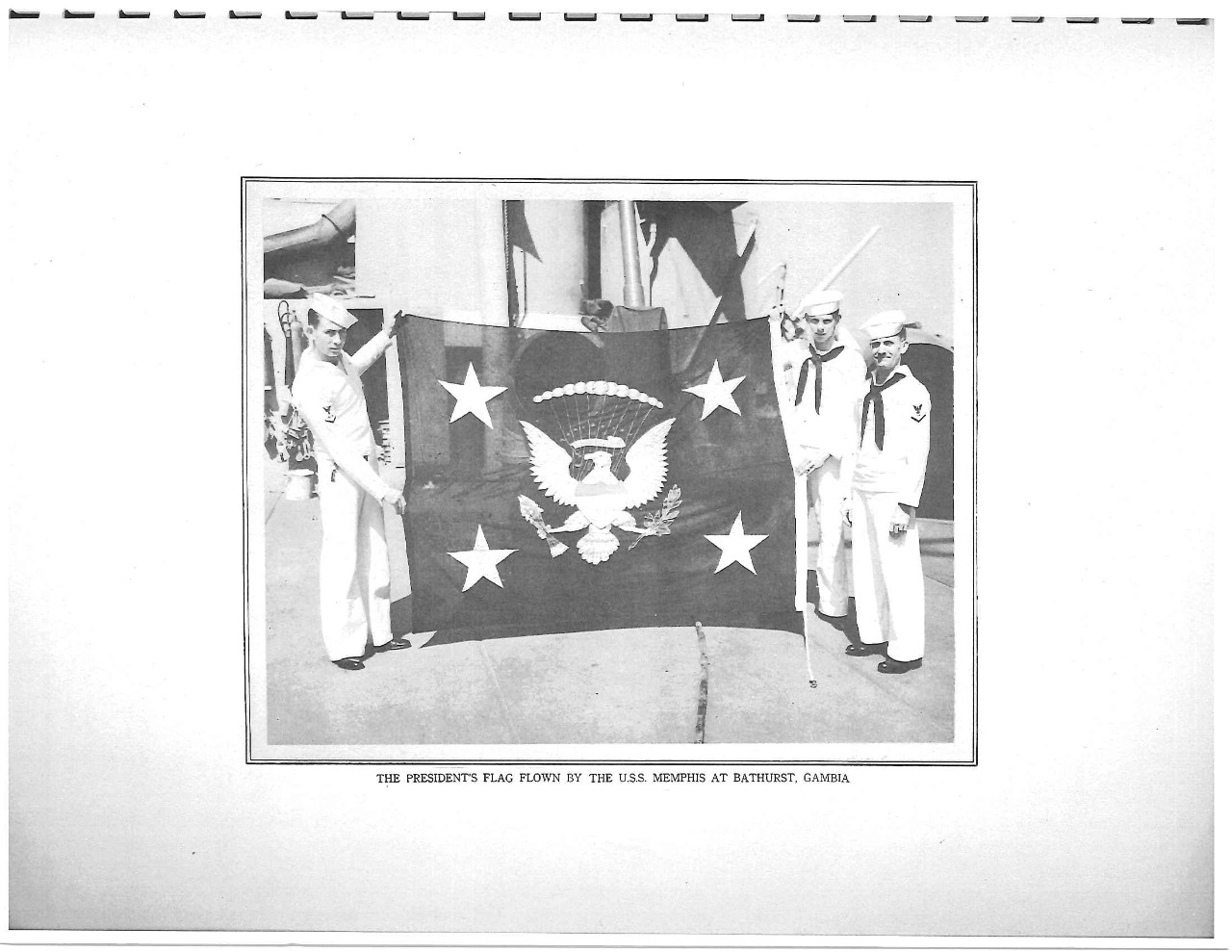
City, Michigan, she was placed in commission on 6 June 1942, her officers and men having been sent from Scotland to America for this purpose. She is Diesel-electric driven and mounts one three-inch fun on the forecastle and two 20mm rapid fire guns on the bridge deck.
Her trip from Bay City, Michigan, to Freetown, Africa, (the latter port being the one out of which she normally operates) was marked by stops at Detroit, Cleveland, Toronto, Quebec, New York, Norfolk, and St. Thomas, V.I.
For the trip across the Atlantic the Aimwell had taken a large, floating, wooden dry dock in tow, capable of accommodating vessels as large as a cruiser. An escort was assigned consisting of two coastal minesweepers and two corvettes. Five days out of Freetown, the dry dock broke her back, although the weather had not been rough, and the dock became unmanageable and started to lose buoyancy. After a survey it was decided that it would be impossible to tow her any farther. She was set on fire, and shortly thereafter the dock sank. This tug, normally good for 14 knots with a clean bottom can now make a bare 12 knots. Manned by a complement of 10 officers and 23 men, she was a compact, powerful little vessel that had been putting herself to good use in towing into port various vessels that had become victims of enemy submarine attack.
After watching the President as he sat chatting on the fantail with the various members of his party, one of the British seamen described the President’s free and easy manner of making himself at home everywhere, with the remark to Chief Ship’s Clerk Terry that, “The President certainly sits ‘proper natural’ back there, doesn’t he?”
After proceeding upriver for an hour, course was reversed at
-39-
6:00 P.M. for it was desired to return to the anchorage before dark. On the run back Mr. Hopkins and Admiral McIntire trolled a couple of lines with feather lures, but had no luck. Anchor was dropped at 6:45 P.M. and upon thanking Commander Lawder and Lt. Commander Vaughan for a pleasant trip, and after saying goodbye to Lord Swinton, the President left the Aimwell for the Memphis, going aboard at 7:00 P.M. The President proceeded aft, where the officers and men of the Memphis had gathered. Here, after being introduced by Captain McCown, the President made this short address:
“I suppose that this is the greatest surprise – this trip of mine, to you and to me both, because nothing like that has happened in the world for a great many years. I said last night when I came aboard that there was just one thing I would like to have – I would like to fly my flag on the Memphis in a harbor off the coast of Africa. I think it is something we will always remember. No President has ever done it before. No ship has ever made a President’s flag in such record time, and it is a darn good flag.
“I can’t tell you much about home – you have only been out three months – but I can tell you that in the past ten days, with the Chiefs of Staff, British and ourselves, we have worked on plans and have agreed unanimously on plans to keep the war going at full speed during the rest of 1943. We hope it will be over by then, but you never can tell. If it is not over we will be even more ready in 1944 for the final victory. It has been good to see you all here, and I will always remember this occasion. Thank you very much.”
The members of the President’s party had all retired by midnight. Six o’clock on the morrow called for an early take-off from Yundum Field at Bathurst for an inspection trip to Roberts Field, near Monrovia, Liberia, 690 miles to the southeast.
-40-
Wednesday 27 January
Leaving the ship in Memphis whaleboat at 7:10 A.M., the President was at the dock by 7:30 and at 8:25 had arrived at Yundum Field. The 18-mile trip from Bathurst was made by automobile. Here, the two four-motored Army transport planes, which had flown the party from Marrakech on Monday were warming up. The President’s plane was in the air at 8:45. Plane #2 took off five minutes later.
The coastline was followed during most of the trip to Liberia, the African state founded in 1822 by Negro freedom from the United States. The President’s plane came to a stop on Roberts Field at 12:40. Waiting to greet him were Brigadier General S. W. Fitzgerald, commanding the African Middle East Wing of the Army Transport Command and Commanding General U.S. Armed Forces in Central African Service General James F. C. Hyde, Commanding General of Central African Service of Supply; Colonel Thomas L. Hardin, A-3; and Colonel Frank H. Collins, Executive Officer.
The President’s party proceeded to General Fitzgerald’s quarters where they freshened up and then went to the officers’ mess hall where the President was greeted by President Edwin Barclay of Liberia, Secretary of State Clarence Simpson, and U. S. Charge d’ Affaires Frederick P. Hibbard.
After pleasantries had been exchanged, the noonday meal was served. The menu consisted of broiled steak, French fired potatoes, boiled buttered beets, corn on the cob, avocado salad, blueberry pie, ice cream, and coffee.
In connection with the tremendous problem of supplying American troops in Africa with the proper kind of food, it might be well to state
-41-
here that with the exception of the items contained in the salad, all of the food served at this meal had been shipped to Africa from the United States. Liberia produces only a very few of the many food items which are necessary to maintain American troops on a healthful diet.
After dinner the President took to a jeep and invited President Barclay to take a place beside him for the review of the troops. Arriving at the parade ground at 2:05, a most excellent band, attached to the 41st Engineers, played first the United States National Anthem and then the National Anthem of Liberia. Following rendition of honors, the two Presidents rode in the jeep up and down lines formed by 35 officers and 450 men, comprising the Defense Detachment, under the command of Colonel A. A. Kirchoff. About 15 of the musicians attached to the 41st Engineers’ Band were formerly musicians in Cab Calloway’s orchestra, and they played “When Irish Eyes are Smiling,” with tenderness and feeling. The President’s jeep then came to a stop where a commanding view of the field could be had. The bank struck up “Anchors Aweigh,” and this battalion of fine appearing, well-trained colored troops passed in review. With the completion of the review, President Roosevelt shook hands with the officers of the detachment, about 50 per cent of whom are white, and the remainder colored.
Mr. G. H. Seybold, General Manager of the nearby Firestone Plantation, joined the party at this point and at 2:30 it proceeded for a tour through a huge rubber plantation. According to Mr. Seybold, there were 78,000 planted acres, 20,000 natives employed, and thirty-five million pounds of rubber produced annually. This is enough to make three million tires of pure rubber, or double that amount if mixed with reclaimed rubber.
-42-
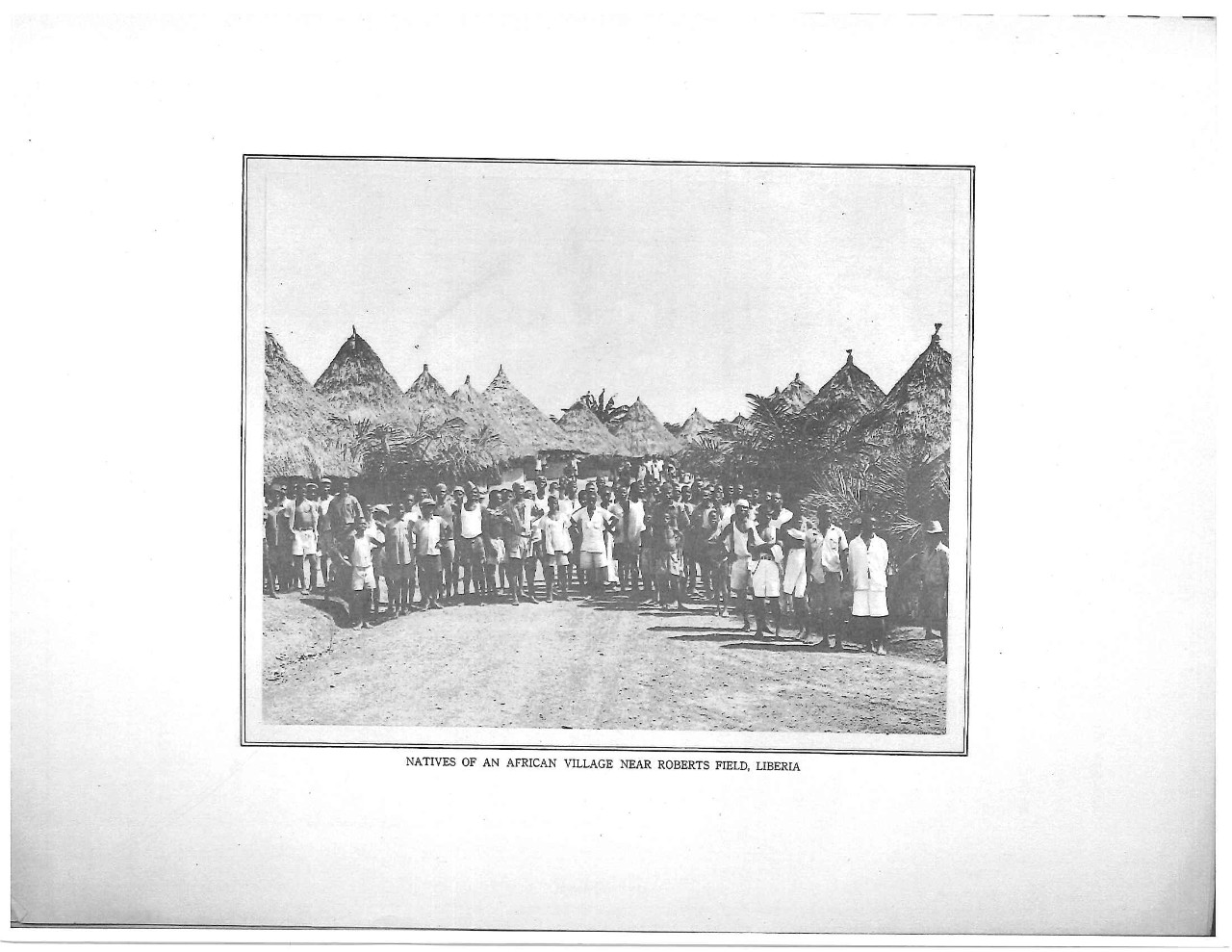
For the next 40 minutes the motorcade wound through various sections of the Firestone Plantation, affording the President a view of rubber plants in all stages of their growth, from young shoots to latex producing trees. Rubber trees do not produce until after the seventh year of their cultivation. During the tour of the plantation, the party passed through a picturesque African village. In front of their mud, thatch-covered huts were many natives, in various forms of dress and undress.
The regular wage for native rubber workers is .18 a day, but because in a few days at this rate, he can earn enough money to take care of most of his needs for a comparatively long period. The “Hut Tax” is $2.00 per year, and his food can be had from trees and plants in the jungle for the picking. The white man’s conception of laziness therefore abounds.
Returning to the airfield at 3:10, the planes took off at 3:25, their powerful motors roaring northwest at 180 miles an hour. Landing at Yundum Field at 7:00 P.M., the President paused in his car for a few minutes to listen to a company of Nigerian soldiers who were singing and marching up and down the field preparatory to leaving for their barracks after a day of duty. This singing and marching at the close of the day is routine with these soldiers, brought to Gambia from Nigeria by the British presumably for the duration of the war.
One of the songs was “Home Again,” undoubtedly taught to them by the missionaries of Nigeria from whom they must have also learned to speak fair English.
There is such a multiplicity of dialects among the natives of
-43-
Gambia that it is extremely difficult if not impossible to make good soldiers of them. The British, therefore, found necessary to conscript the Nigerians for service in Gambia. They sand extremely well and harmoniously, but a wild, primitive strain in their songs must have come straight from primeval hearts, for these black men had not long known the ways and customs of the white man.
It was said that the British had allowed these natives to gain the impression that should the United Nations successfully conclude the war, they were to be allowed to go to American to take up farming.
Leaving the dock at 8:10 the President’s whaleboat was hoisted aboard the Memphis at 8:30. Tonight the party was to return across the Atlantic to Natal, Brazil, in the Boeing Clippers, which had brought them from Belem to Bathurst two weeks before. Baggage was collected and goodbyes were said to friends on the Memphis.
At 10:25 P.M. the party left that vessel. The President was safely on board his big Clipper by a few minutes before eleven, and at 11:36 P.M. Plane #2, executed a night take-off. The President’s plane followed a few minutes later.
Thursday 28 January
During most of the night the President’s plane, which was flying high, encountered bumpy weather. It could not be called a comfortable crossing. Plane #2, after cruising at 7500 feet for four hours, descended to 1000 feet for the rest of the run to Natal and had smooth flying all of the way. For the last two hours out of Natal, it had been necessary for Plane #2 to feather Number 3 engine, as piston trouble had developed and
-44-
the engine was throwing oil and pounding. Three hours were gained in flying westward during the night. The President’s plane landed at Natal at 7:50 A.M., local time, after a flight of 11 hours and 20 minutes from Bathurst. Plane #2 executed a perfect landing at Natal at 8:15, local time, despite the fact that the pilot did not have the use of Number 3 motor.
A few minutes after landing the President was greeted by Vice Admiral Jonas Ingram. Commander South Atlantic Force. The President and his party were soon aboard the USS Humboldt, a new seaplane tender, which Admiral Ingram had arranged to bring to Natal in order that suitable living quarters might be available to the President and to provide appropriate accommodations in which the President could confer with President Getulio Vargas of Brazil, a meeting which had been arranged for when the President’s trip was still in the planning stage.
President Vargas came on board the Humboldt at 11:45 A.M., accompanied by U. S. Ambassador Jefferson Caffery and Rear Admiral A. T. Beauregard, Chief of the U. S. Naval Mission to Brazil. The President greeted President Vargas warmly for they were old friends. After chatting on deck for some time, the two presidents sat for a number of still and moving pictures, others in the group being Mr. Hopkins, Ambassador Caffery, Vice Admiral Ingram, Rear Admiral Beauregard, Rear Admiral McIntire, and Brigadier General Robert L. Walsh. After the pictures had been taken, the group went to the President’s cabin for luncheon.
The two presidents left the Humboldt at 2:25 and, upon reaching the Pan-American dock, transferred to an Army jeep for an inspection of the local United States and Brazilian shore installations. Vice Admiral
-45-
Ingram also rode in this jeep.
The personnel of U.S. Navy Patrol Squadron 74, were formed adjacent to the Pan-American dock. After honors and been rendered, the inspecting party rode down the lines of officers and men, resplendent in white uniforms.
At the dock the two presidents had been greeted by General Cordeiro de Faria, the Brazilian Army Commander of the Natal Area, Admiral Ary Parreira, Commander, of the Naval Base at Natal, and Sr. Raphael Fernandez, Governor of the State of Natal. The President’s party then proceeded to a Brazilian artillery post located on a rise of ground nearby, and General Cordeiro pointed out the location and function of the various harbor defense batteries.
The President then transferred from his jeep to a more comfortable sedan, preparatory to passing through the main section of the city of Natal, en route to Parnamarim Field, 10 miles outside the city. This field is the headquarters of the South Atlantic Wing of the Army Transport Command, and also the headquarters of the Ninth Ferry Group of the South Atlantic Wing.
Parnamarim Field is part of the command of Brigadier General Robert L. Walsh. The Navy also maintains a unit of aircraft at this field – Patrol Squadron 83, under the command of Lt. Commander Loomis. This is one of the largest stations of the Army Transport and Ferry Command, reminding one of a high municipal airport such as LaGuardia Field in New York or the Municipal Airport in Chicago. One of the officers mention that even though he had been here for some time, it still “made his spine tingle” to watch the two-engined B-26’s zooming off at daybreak, one after
-46-
another, bound for Africa, via Ascension Island.
The President made a very extensive tour of the station, and particularly noted the large number of new buildings, roads, and runways being constructed, the work for the most part being done by native labor. Toward the latter part of the trip around the field, he passed by the section now allocated to a Brazilian air unit, it having formerly been under the control of a commercial airline, “Air-France.” When the President left the field at 4:20, he received a round of applause from the assembled officers, men, and workmen. Returning to the Pan-American dock at five o’clock, fifteen minute later the President was back on board the Humboldt.
President Vargas and Ambassador Caffery dined with the President and Mr. Hopkins on board the Humboldt this evening. During the course of the dinner, a joint statement by the two presidents, outlining the purpose of the President’s stop at Natal and renewing pledges of mutual aid, was agreed upon for release to Brazilian and United States papers appearing on the streets Saturday morning, 30 January.
The President of Brazil and Ambassador Caffery left the ship at 9:45 P.M., and the President retired shortly thereafter.
Friday 29 January
After having had about five hours’ sleep, the President’s party was up at 4:00 A.M. this morning, and after an early breakfast the President left the Humboldt at 5:10. Disembarking at the Pan-American dock, he was soon on his way to Parnamarim Field, where he arrived at 5:50. At the field, two Army C-54 transports were waiting to take the party to
-47-
Trinidad. After shaking hands and saying goodbye to Admiral Ingram, the President boarded his plane and was in the air, winging northward, at six o’clock. Plane #2 followed at 6:15. The two Clippers had been given orders to proceed independently and rendezvous with us at Trinidad.
The flight to Trinidad, through huge white cloudbanks and wide expanses of blue water, was without incident. The planes flew steadily on their way to Trinidad at altitudes from eight to ten thousand feet and at a ground speed of about 180 miles per hour.
Plane #2 had overhauled and passed Plane #1 during the afternoon, and after circling for a half hour over Waller Field at Trinidad, was finally given permission to land five minutes in advance of the President’s plane, which rolled down the runway at 4:15, local time, after a flight of 11 hours and 15 minutes from Natal, 2135 miles to the southeast.
At Waller Field the President was greeted by his Chief of Staff, Admiral William D. Leahy, U.S.N., who had remained at Trinidad having spent a week of this time in the hospital throwing off a bad chest cold.
Rear Admiral J. B. Oldendorf, U.S.N., Commandant of the Naval Operating Base at Trinidad, and Major General Henry C. Pratt, Commanding General Trinidad Base Command, were also on hand to greet the President, as was Brigadier General Summers, who commands the mobile forces at the Trinidad base. These officers rode with the President during the automobile inspection of Waller Field and Fort Read, and also during the 30-odd mile ride to Macqueripe Beach Hotel.
Eh route to the hotel the party drove through the city of Port of Spain, the townspeople having lined the streets in the hope of catching a glimpse of the President as he passed. Before arriving at the hotel
-48-
a stop was made at the Control Gate of the Naval Operating Base, where the President greeted Colonel Mueller, Trinidad Police Commissioner.
Back amid the delightful surroundings of the Macqueripe Beach Hotel at 5:45, the President, over a cocktail, chatted with General Pratt and Admiral Oldendorf. Admiral Oldendorf, General Pratt, and General Summers dined with the President on the second floor veranda just outside the President’s comfortable suite. The Naval officers in charge of the arrangements at the hotel were most thoughtful in providing every facility for the comfort of the President and his party. A good night’s rest was had by all.
Saturday 30 January
This was to be the last day in the air for today the Presidential party was to fly from Trinidad to Miami, where the President’s train was waiting to take him to Washington.
When the President reached his Clipper shortly before seven o’clock this morning, the following signal was flying from his plane:
Internationa Signal Flags |
Meaning
|
| DNW | CinC |
| CAX | Birth |
| ELV | Day |
| GUB | Greetings |
Today was the President’s 61st birthday, and he was to spend t in the air on the last leg of a precedent-shattering trip by air during which he had flown in excess of 14,000 miles, over land and sea.
The President’s plane was in the air at 7:10 A.M., and Plane #2 followed two minutes later. In passing over Haiti, shortly after noon,
-49-
the flight circled the city of Port au Prince for a few minutes in order to afford the President a view from the air.
Preparations had been going on in both planes all during the morning for a birthday party for the President, which was to commence at 12:30. Exactly at 12:30 the passengers in Plane #2 lifted-their glasses to the President, whose plane could be seen easily only a short distance away. At this time, Captain McCrea delivered the following message to the President from Lt. Commander John C. Leslie, U.S.N.R., the Pan-American representative who had accompanied the Clippers on their trip to Africa and return:
“Passengers and crew of Clipper No.2 request you to inform the President that they will drink to his health and happiness at 1620 GMT, wishing him many happy returns of his birthday. That our Commander-in-Chief should for the first time be celebrating his birthday in the vast freedom of the sky seems to us symbolic of the new day for which we are all fighting with one mild and heart.”
At this time the President was also presented with a bound collection of old prints of scenes in and around Port of Spain, Trinidad, a joint gift of the members of his party during the trip to Africa. Chief Ship’s Clerk Terry penned a card to which all members of the party affixed their signatures.
The President was made very happy by the receipt of both the volume of prints and the card. Congratulatory messages were also given to the President from Admiral Ingram, on behalf of the “boys in blue” in the South Atlantic and from the officers and men of the Naval Operating Base at Trinidad.
The President’s plane landed in the beautiful waters of Biscayne
-50-
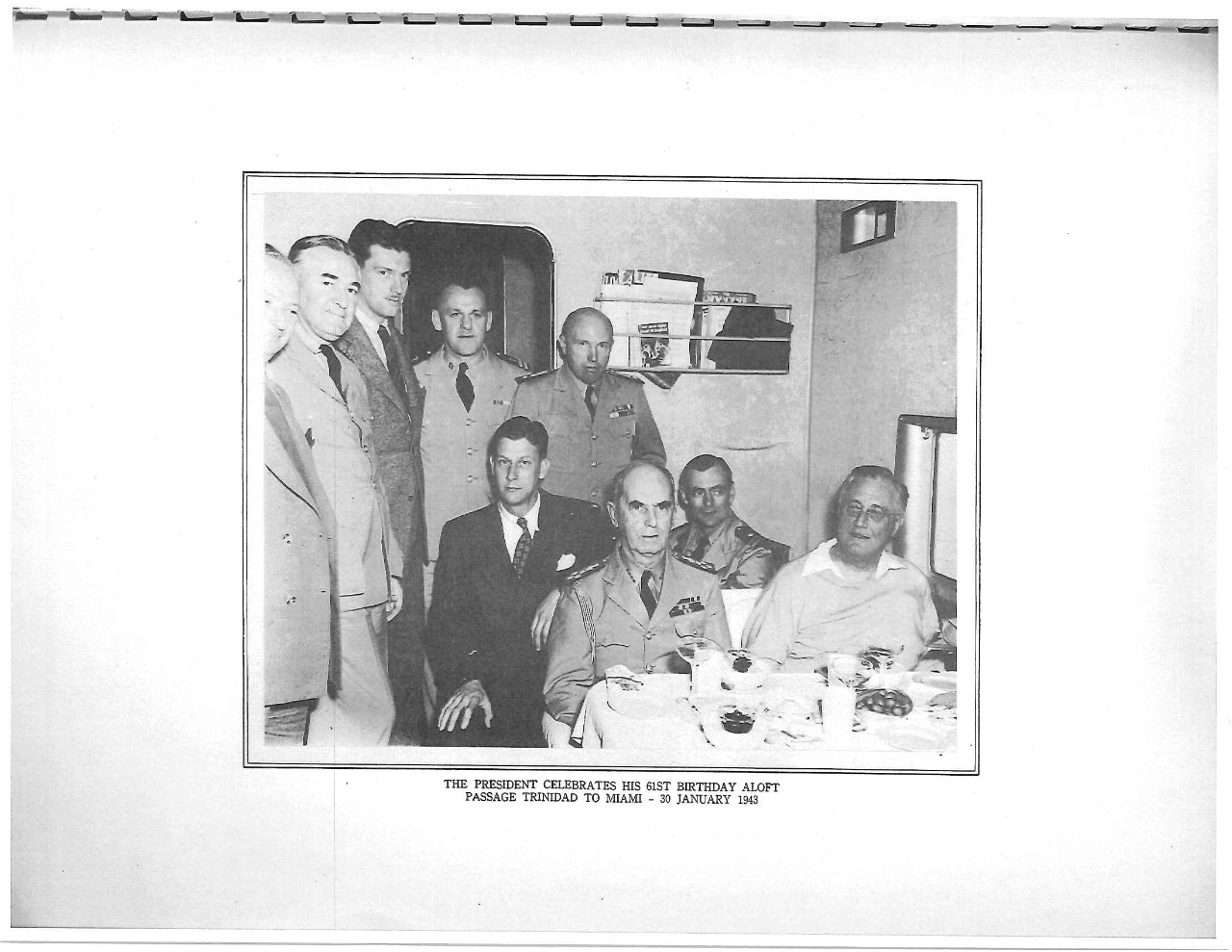
Bay at Miami exactly at 4:35 P.M. The weather throughout the trip from Trinidad was very good. The Party had flown at about 8000 feet for the greater part of the day.
Upon arrival at Miami, the President was met by Rear Admiral J.L. Kauffman, U.S.N., Commandant Seventh Naval District, who rode with the President to the train a few blocks away. It was not long until baggage had been stowed aboard, and the members had found their rooms. The “Presidential Special” left for Washington at 6:00 P.M.
Sunday 31 January
The three additional mess attendants had reported from the Potomac, and the messing and berthing arrangements were quite satisfactory during the return trip.
About four hours out of Washington, snow and ice were noticed. Upon arriving in Washington at 6:30 P.M., the party found about four inches of snow on the ground. It was quite a contrast since the President and his party had crossed the equator only two days before.
51



